Bandcamp Chatbot Integration: Project Design, Implementation Report
VerifiedAdded on 2024/06/11
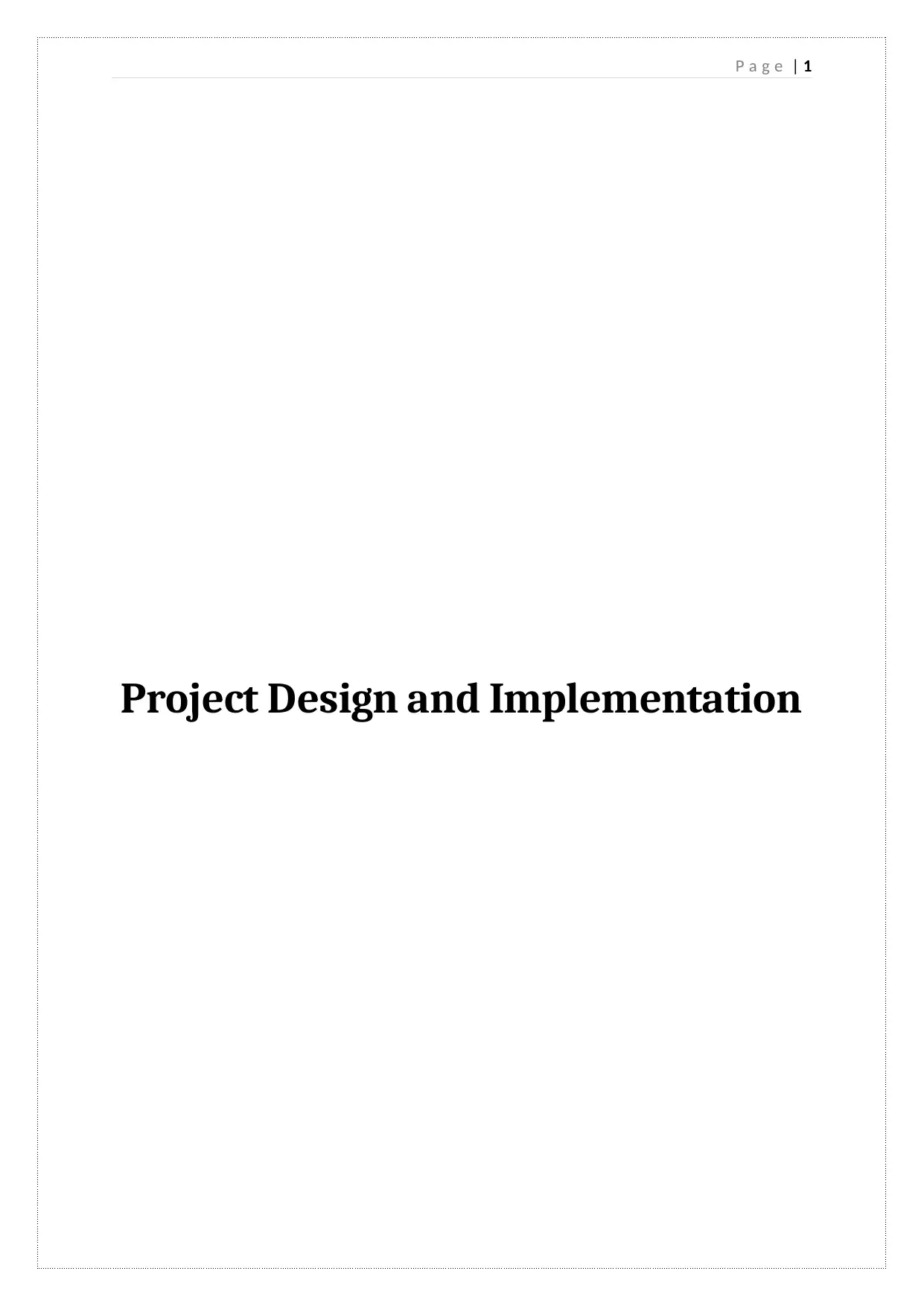
Project Design and Implementation
Paraphrase This Document
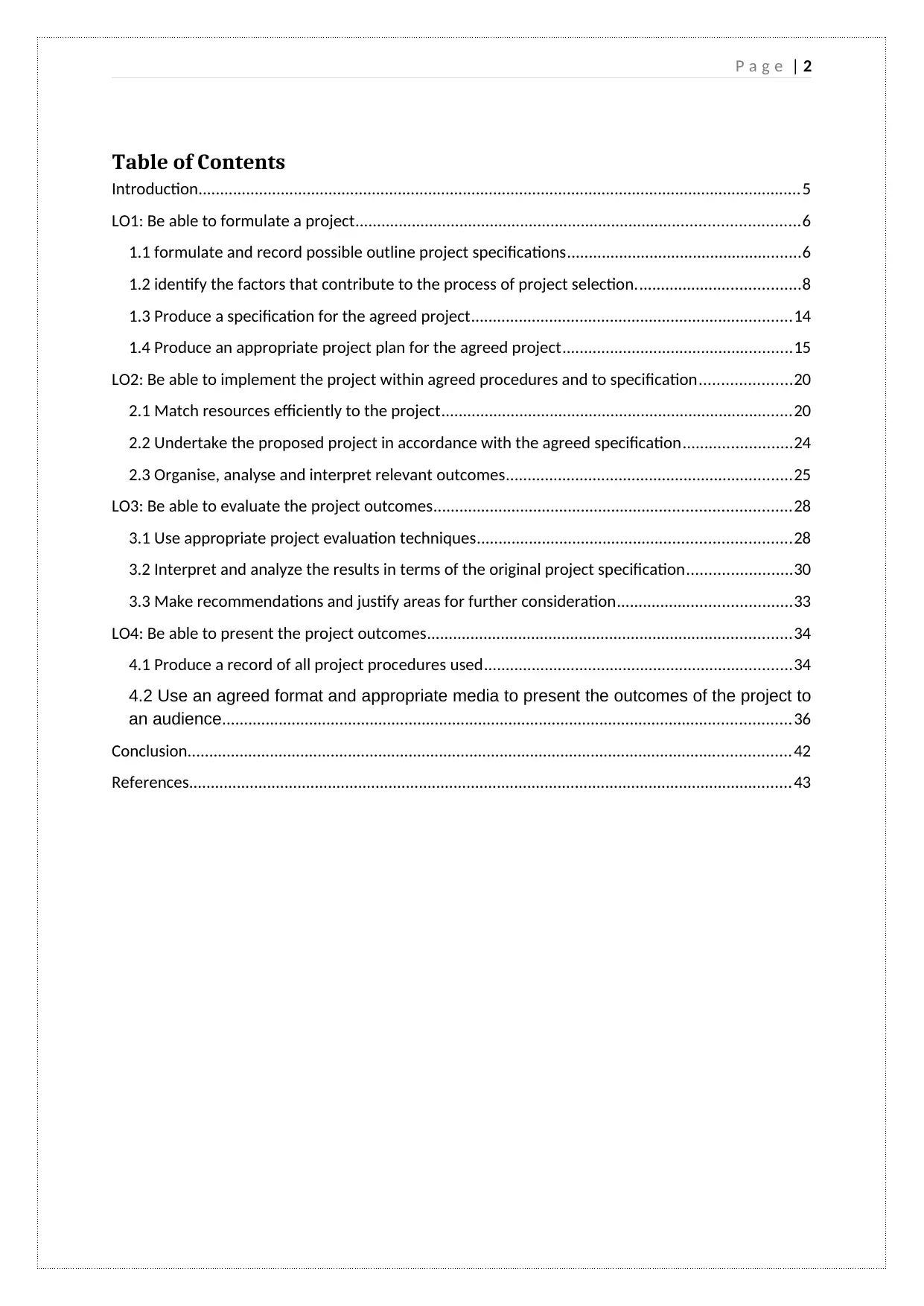
Table of Contents
Introduction...........................................................................................................................................5
LO1: Be able to formulate a project......................................................................................................6
1.1 formulate and record possible outline project specifications......................................................6
1.2 identify the factors that contribute to the process of project selection......................................8
1.3 Produce a specification for the agreed project..........................................................................14
1.4 Produce an appropriate project plan for the agreed project.....................................................15
LO2: Be able to implement the project within agreed procedures and to specification.....................20
2.1 Match resources efficiently to the project.................................................................................20
2.2 Undertake the proposed project in accordance with the agreed specification.........................24
2.3 Organise, analyse and interpret relevant outcomes..................................................................25
LO3: Be able to evaluate the project outcomes..................................................................................28
3.1 Use appropriate project evaluation techniques........................................................................28
3.2 Interpret and analyze the results in terms of the original project specification........................30
3.3 Make recommendations and justify areas for further consideration........................................33
LO4: Be able to present the project outcomes....................................................................................34
4.1 Produce a record of all project procedures used.......................................................................34
4.2 Use an agreed format and appropriate media to present the outcomes of the project to
an audience...................................................................................................................................36
Conclusion...........................................................................................................................................42
References...........................................................................................................................................43
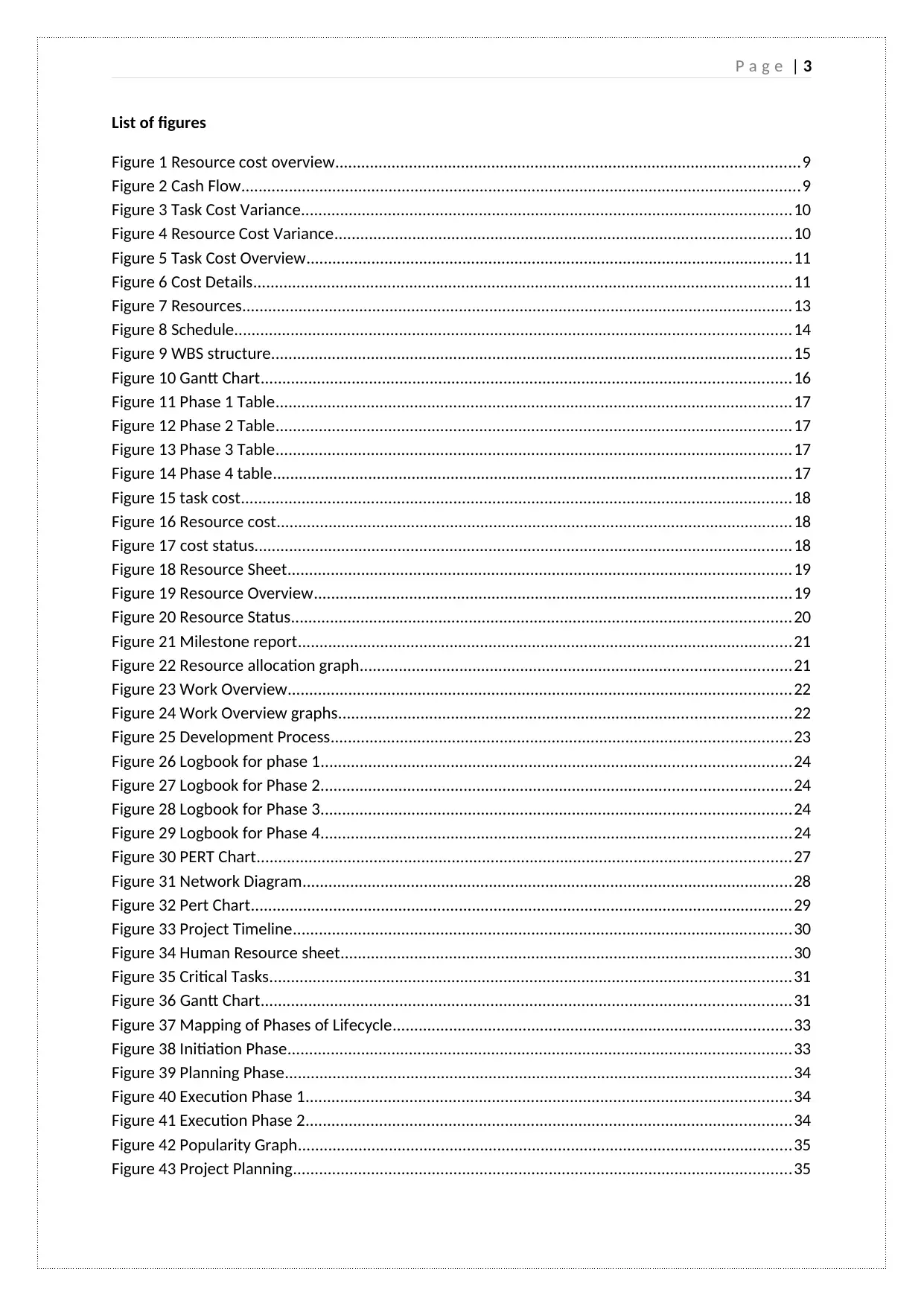
List of figures
Figure 1 Resource cost overview...........................................................................................................9
Figure 2 Cash Flow.................................................................................................................................9
Figure 3 Task Cost Variance.................................................................................................................10
Figure 4 Resource Cost Variance.........................................................................................................10
Figure 5 Task Cost Overview................................................................................................................11
Figure 6 Cost Details............................................................................................................................11
Figure 7 Resources...............................................................................................................................13
Figure 8 Schedule................................................................................................................................14
Figure 9 WBS structure........................................................................................................................15
Figure 10 Gantt Chart..........................................................................................................................16
Figure 11 Phase 1 Table.......................................................................................................................17
Figure 12 Phase 2 Table.......................................................................................................................17
Figure 13 Phase 3 Table.......................................................................................................................17
Figure 14 Phase 4 table.......................................................................................................................17
Figure 15 task cost...............................................................................................................................18
Figure 16 Resource cost.......................................................................................................................18
Figure 17 cost status............................................................................................................................18
Figure 18 Resource Sheet....................................................................................................................19
Figure 19 Resource Overview..............................................................................................................19
Figure 20 Resource Status...................................................................................................................20
Figure 21 Milestone report..................................................................................................................21
Figure 22 Resource allocation graph...................................................................................................21
Figure 23 Work Overview....................................................................................................................22
Figure 24 Work Overview graphs........................................................................................................22
Figure 25 Development Process..........................................................................................................23
Figure 26 Logbook for phase 1............................................................................................................24
Figure 27 Logbook for Phase 2............................................................................................................24
Figure 28 Logbook for Phase 3............................................................................................................24
Figure 29 Logbook for Phase 4............................................................................................................24
Figure 30 PERT Chart...........................................................................................................................27
Figure 31 Network Diagram.................................................................................................................28
Figure 32 Pert Chart.............................................................................................................................29
Figure 33 Project Timeline...................................................................................................................30
Figure 34 Human Resource sheet........................................................................................................30
Figure 35 Critical Tasks........................................................................................................................31
Figure 36 Gantt Chart..........................................................................................................................31
Figure 37 Mapping of Phases of Lifecycle............................................................................................33
Figure 38 Initiation Phase....................................................................................................................33
Figure 39 Planning Phase.....................................................................................................................34
Figure 40 Execution Phase 1................................................................................................................34
Figure 41 Execution Phase 2................................................................................................................34
Figure 42 Popularity Graph..................................................................................................................35
Figure 43 Project Planning...................................................................................................................35
⊘ This is a preview!⊘
Do you want full access?
Subscribe today to unlock all pages.

Trusted by 1+ million students worldwide
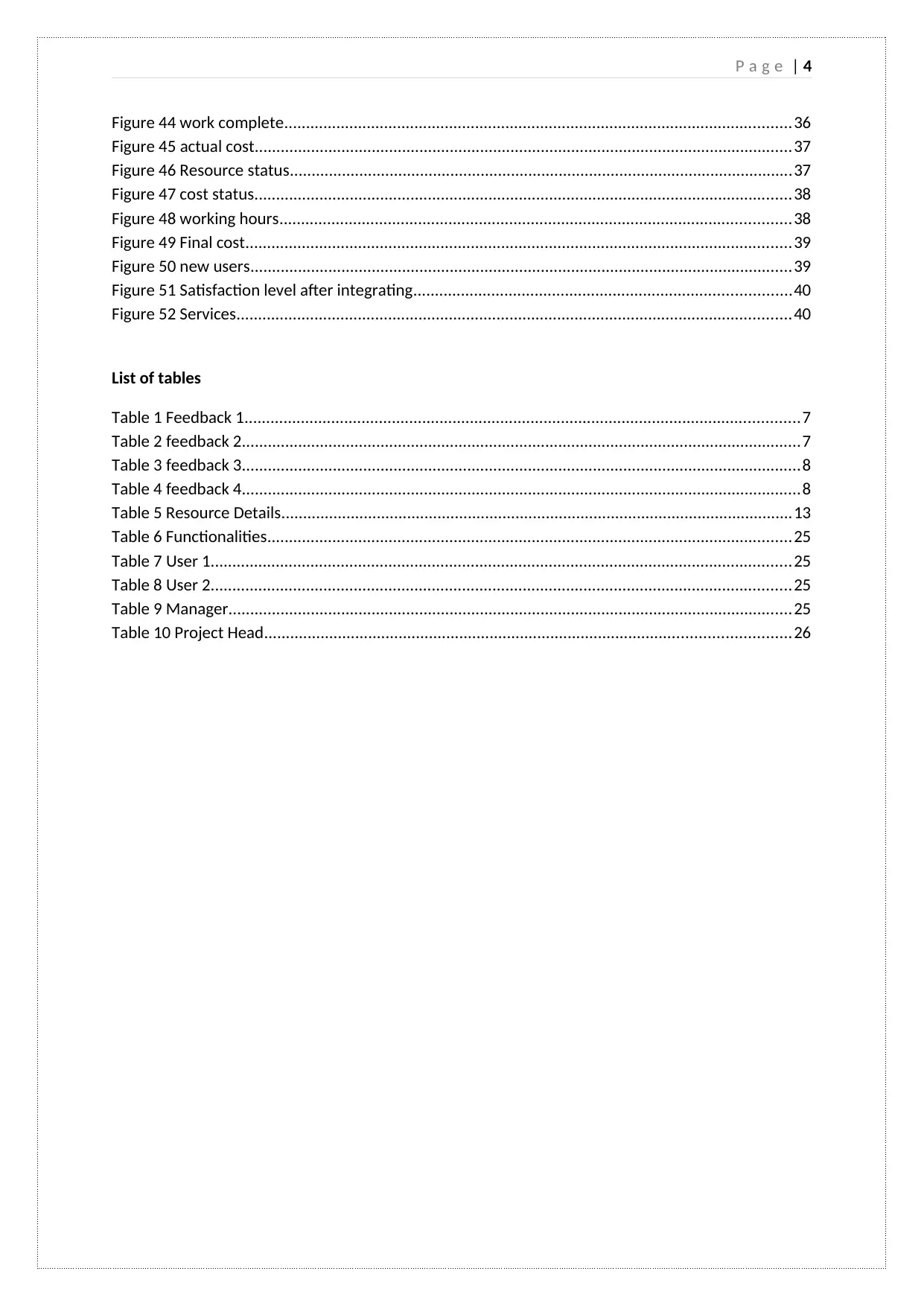
Figure 44 work complete.....................................................................................................................36
Figure 45 actual cost............................................................................................................................37
Figure 46 Resource status....................................................................................................................37
Figure 47 cost status............................................................................................................................38
Figure 48 working hours......................................................................................................................38
Figure 49 Final cost..............................................................................................................................39
Figure 50 new users.............................................................................................................................39
Figure 51 Satisfaction level after integrating.......................................................................................40
Figure 52 Services................................................................................................................................40
List of tables
Table 1 Feedback 1................................................................................................................................7
Table 2 feedback 2.................................................................................................................................7
Table 3 feedback 3.................................................................................................................................8
Table 4 feedback 4.................................................................................................................................8
Table 5 Resource Details......................................................................................................................13
Table 6 Functionalities.........................................................................................................................25
Table 7 User 1......................................................................................................................................25
Table 8 User 2......................................................................................................................................25
Table 9 Manager..................................................................................................................................25
Table 10 Project Head.........................................................................................................................26
Paraphrase This Document
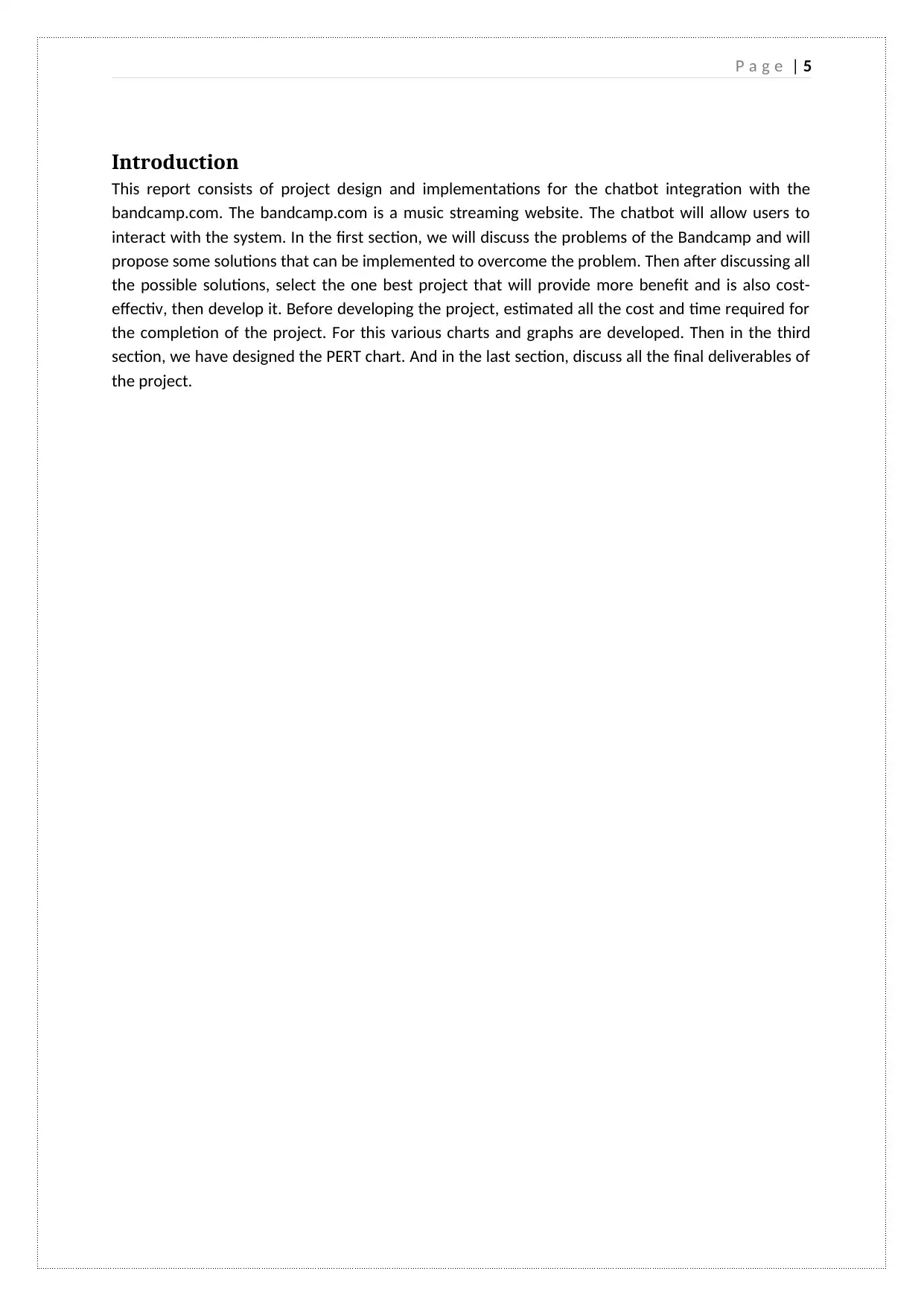
Introduction
This report consists of project design and implementations for the chatbot integration with the
bandcamp.com. The bandcamp.com is a music streaming website. The chatbot will allow users to
interact with the system. In the first section, we will discuss the problems of the Bandcamp and will
propose some solutions that can be implemented to overcome the problem. Then after discussing all
the possible solutions, select the one best project that will provide more benefit and is also cost-
effectiv, then develop it. Before developing the project, estimated all the cost and time required for
the completion of the project. For this various charts and graphs are developed. Then in the third
section, we have designed the PERT chart. And in the last section, discuss all the final deliverables of
the project.
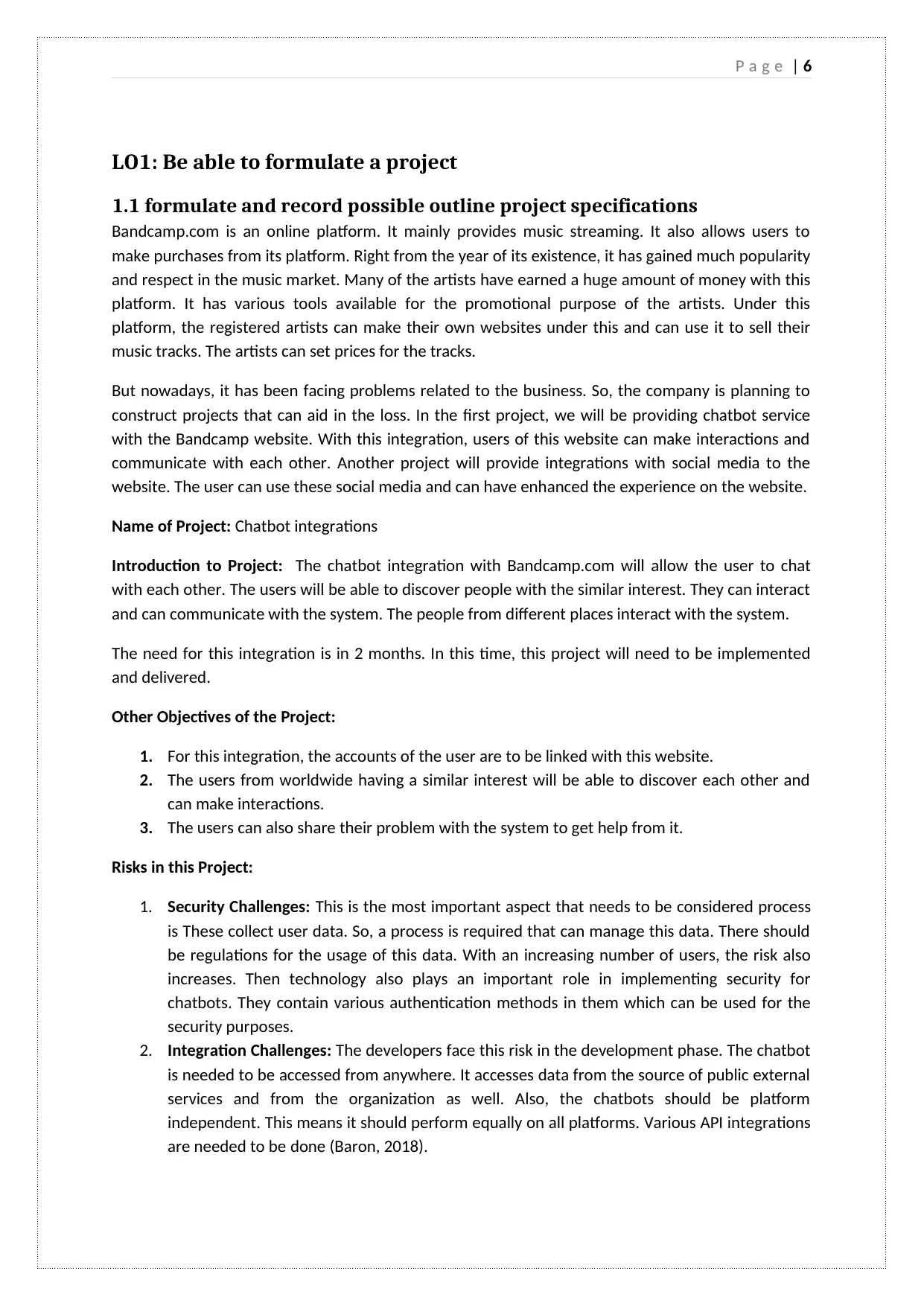
LO1: Be able to formulate a project
1.1 formulate and record possible outline project specifications
Bandcamp.com is an online platform. It mainly provides music streaming. It also allows users to
make purchases from its platform. Right from the year of its existence, it has gained much popularity
and respect in the music market. Many of the artists have earned a huge amount of money with this
platform. It has various tools available for the promotional purpose of the artists. Under this
platform, the registered artists can make their own websites under this and can use it to sell their
music tracks. The artists can set prices for the tracks.
But nowadays, it has been facing problems related to the business. So, the company is planning to
construct projects that can aid in the loss. In the first project, we will be providing chatbot service
with the Bandcamp website. With this integration, users of this website can make interactions and
communicate with each other. Another project will provide integrations with social media to the
website. The user can use these social media and can have enhanced the experience on the website.
Name of Project: Chatbot integrations
Introduction to Project: The chatbot integration with Bandcamp.com will allow the user to chat
with each other. The users will be able to discover people with the similar interest. They can interact
and can communicate with the system. The people from different places interact with the system.
The need for this integration is in 2 months. In this time, this project will need to be implemented
and delivered.
Other Objectives of the Project:
1. For this integration, the accounts of the user are to be linked with this website.
2. The users from worldwide having a similar interest will be able to discover each other and
can make interactions.
3. The users can also share their problem with the system to get help from it.
Risks in this Project:
1. Security Challenges: This is the most important aspect that needs to be considered process
is These collect user data. So, a process is required that can manage this data. There should
be regulations for the usage of this data. With an increasing number of users, the risk also
increases. Then technology also plays an important role in implementing security for
chatbots. They contain various authentication methods in them which can be used for the
security purposes.
2. Integration Challenges: The developers face this risk in the development phase. The chatbot
is needed to be accessed from anywhere. It accesses data from the source of public external
services and from the organization as well. Also, the chatbots should be platform
independent. This means it should perform equally on all platforms. Various API integrations
are needed to be done (Baron, 2018).
⊘ This is a preview!⊘
Do you want full access?
Subscribe today to unlock all pages.

Trusted by 1+ million students worldwide

Paraphrase This Document
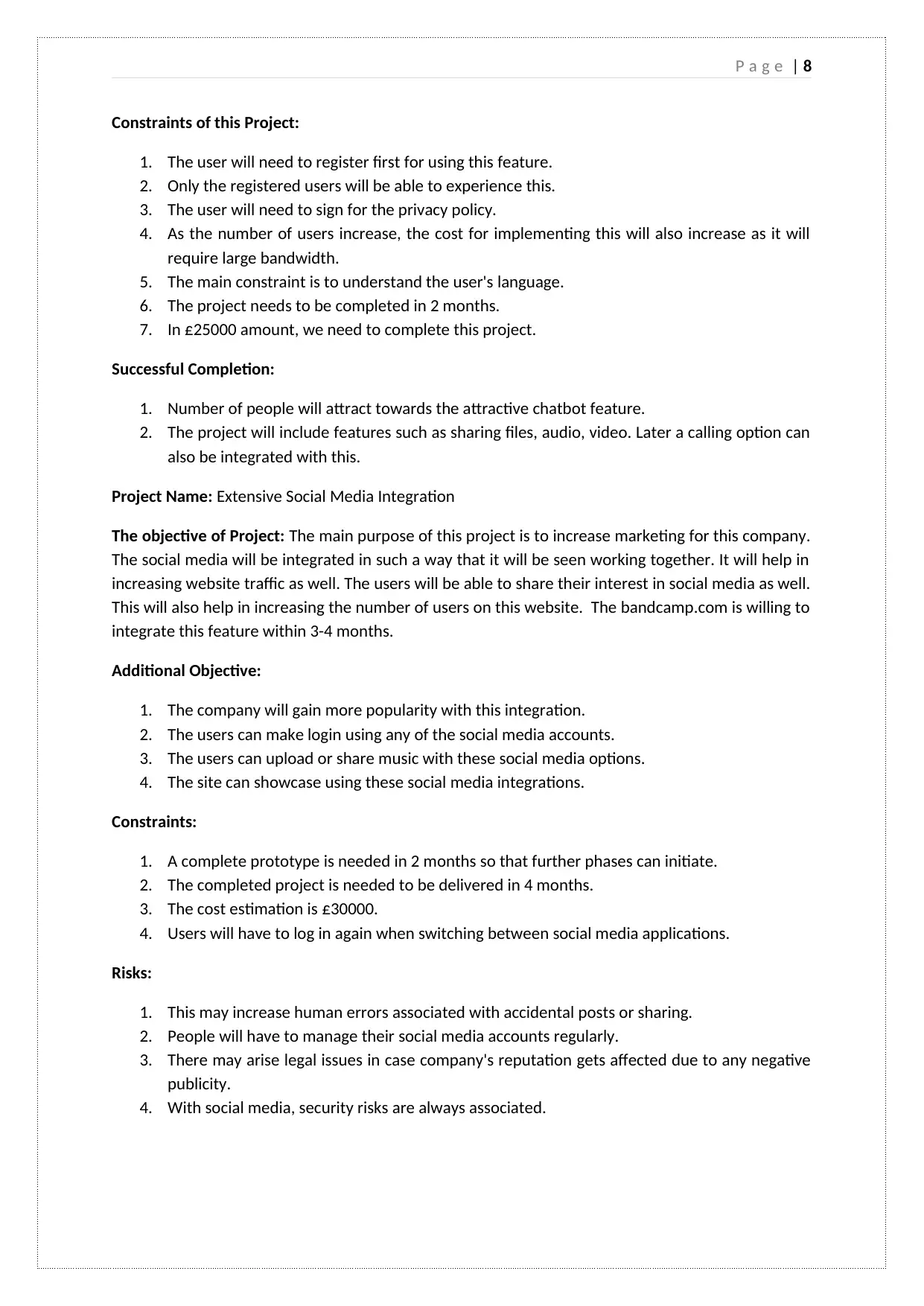
Constraints of this Project:
1. The user will need to register first for using this feature.
2. Only the registered users will be able to experience this.
3. The user will need to sign for the privacy policy.
4. As the number of users increase, the cost for implementing this will also increase as it will
require large bandwidth.
5. The main constraint is to understand the user's language.
6. The project needs to be completed in 2 months.
7. In £25000 amount, we need to complete this project.
Successful Completion:
1. Number of people will attract towards the attractive chatbot feature.
2. The project will include features such as sharing files, audio, video. Later a calling option can
also be integrated with this.
Project Name: Extensive Social Media Integration
The objective of Project: The main purpose of this project is to increase marketing for this company.
The social media will be integrated in such a way that it will be seen working together. It will help in
increasing website traffic as well. The users will be able to share their interest in social media as well.
This will also help in increasing the number of users on this website. The bandcamp.com is willing to
integrate this feature within 3-4 months.
Additional Objective:
1. The company will gain more popularity with this integration.
2. The users can make login using any of the social media accounts.
3. The users can upload or share music with these social media options.
4. The site can showcase using these social media integrations.
Constraints:
1. A complete prototype is needed in 2 months so that further phases can initiate.
2. The completed project is needed to be delivered in 4 months.
3. The cost estimation is £30000.
4. Users will have to log in again when switching between social media applications.
Risks:
1. This may increase human errors associated with accidental posts or sharing.
2. People will have to manage their social media accounts regularly.
3. There may arise legal issues in case company's reputation gets affected due to any negative
publicity.
4. With social media, security risks are always associated.
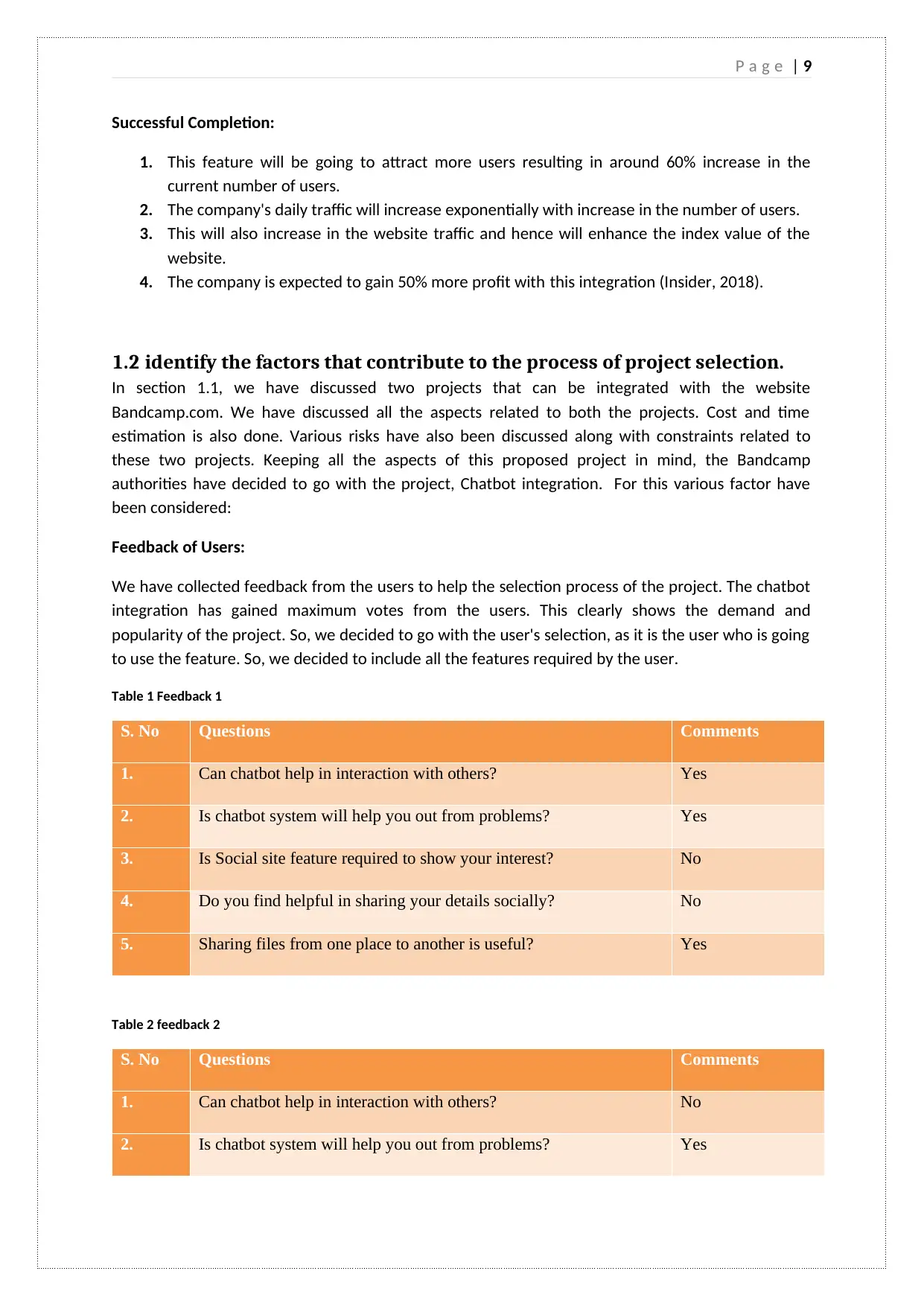
Successful Completion:
1. This feature will be going to attract more users resulting in around 60% increase in the
current number of users.
2. The company's daily traffic will increase exponentially with increase in the number of users.
3. This will also increase in the website traffic and hence will enhance the index value of the
website.
4. The company is expected to gain 50% more profit with this integration (Insider, 2018).
1.2 identify the factors that contribute to the process of project selection.
In section 1.1, we have discussed two projects that can be integrated with the website
Bandcamp.com. We have discussed all the aspects related to both the projects. Cost and time
estimation is also done. Various risks have also been discussed along with constraints related to
these two projects. Keeping all the aspects of this proposed project in mind, the Bandcamp
authorities have decided to go with the project, Chatbot integration. For this various factor have
been considered:
Feedback of Users:
We have collected feedback from the users to help the selection process of the project. The chatbot
integration has gained maximum votes from the users. This clearly shows the demand and
popularity of the project. So, we decided to go with the user's selection, as it is the user who is going
to use the feature. So, we decided to include all the features required by the user.
Table 1 Feedback 1
S. No Questions Comments
1. Can chatbot help in interaction with others? Yes
2. Is chatbot system will help you out from problems? Yes
3. Is Social site feature required to show your interest? No
4. Do you find helpful in sharing your details socially? No
5. Sharing files from one place to another is useful? Yes
Table 2 feedback 2
S. No Questions Comments
1. Can chatbot help in interaction with others? No
2. Is chatbot system will help you out from problems? Yes
⊘ This is a preview!⊘
Do you want full access?
Subscribe today to unlock all pages.

Trusted by 1+ million students worldwide
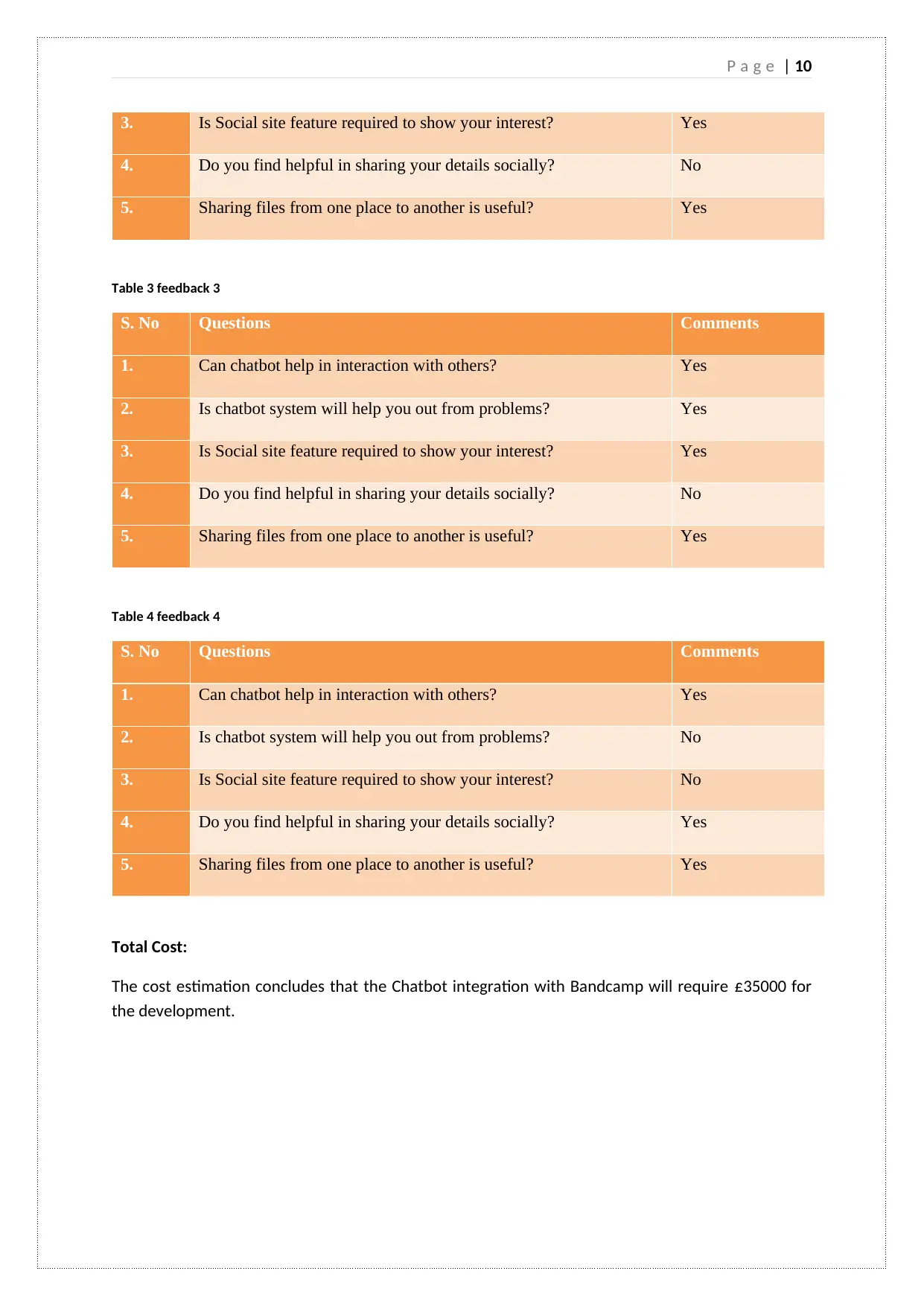
3. Is Social site feature required to show your interest? Yes
4. Do you find helpful in sharing your details socially? No
5. Sharing files from one place to another is useful? Yes
Table 3 feedback 3
S. No Questions Comments
1. Can chatbot help in interaction with others? Yes
2. Is chatbot system will help you out from problems? Yes
3. Is Social site feature required to show your interest? Yes
4. Do you find helpful in sharing your details socially? No
5. Sharing files from one place to another is useful? Yes
Table 4 feedback 4
S. No Questions Comments
1. Can chatbot help in interaction with others? Yes
2. Is chatbot system will help you out from problems? No
3. Is Social site feature required to show your interest? No
4. Do you find helpful in sharing your details socially? Yes
5. Sharing files from one place to another is useful? Yes
Total Cost:
The cost estimation concludes that the Chatbot integration with Bandcamp will require £35000 for
the development.
Paraphrase This Document
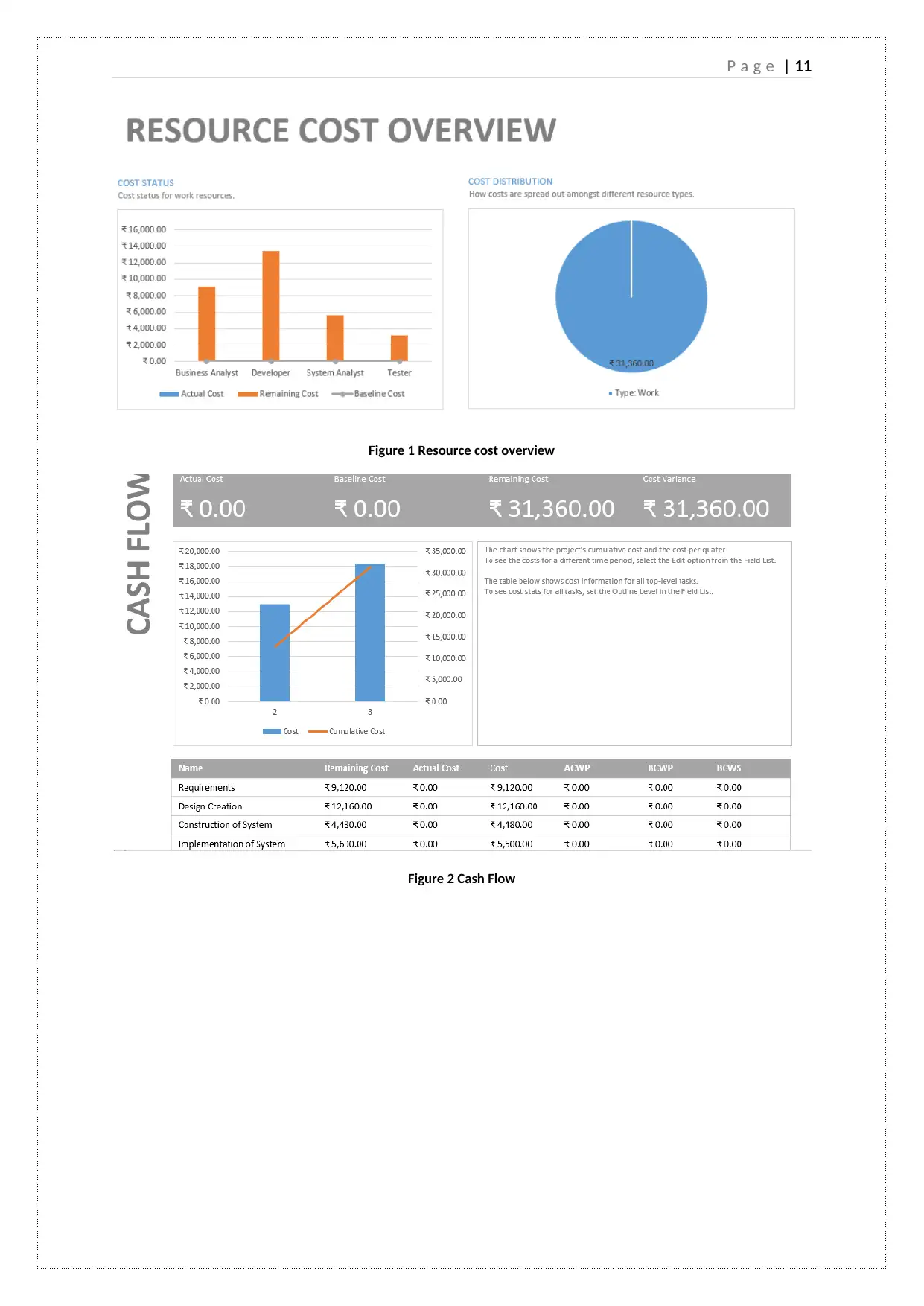
Figure 1 Resource cost overview
Figure 2 Cash Flow
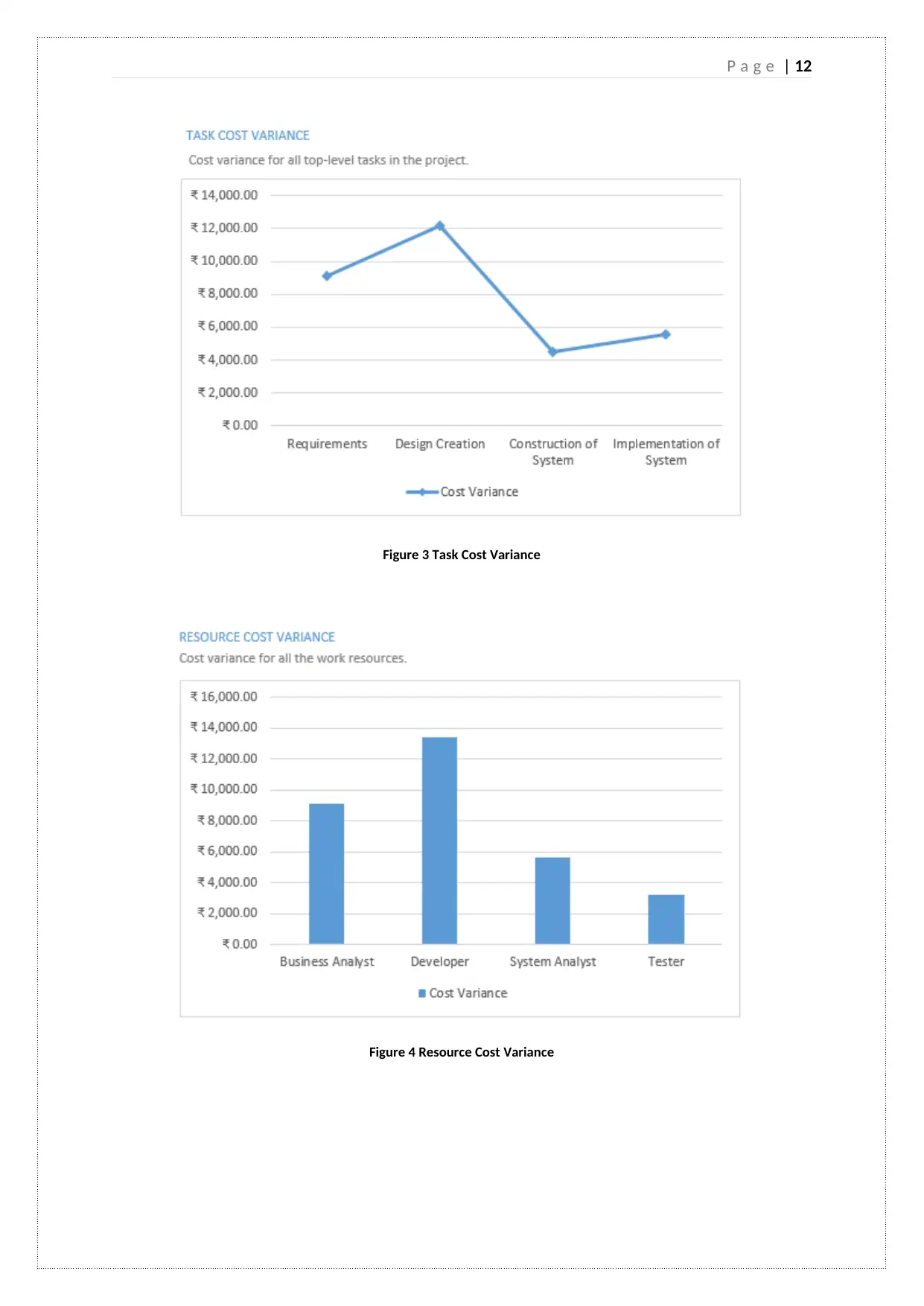
Figure 3 Task Cost Variance
Figure 4 Resource Cost Variance
⊘ This is a preview!⊘
Do you want full access?
Subscribe today to unlock all pages.

Trusted by 1+ million students worldwide
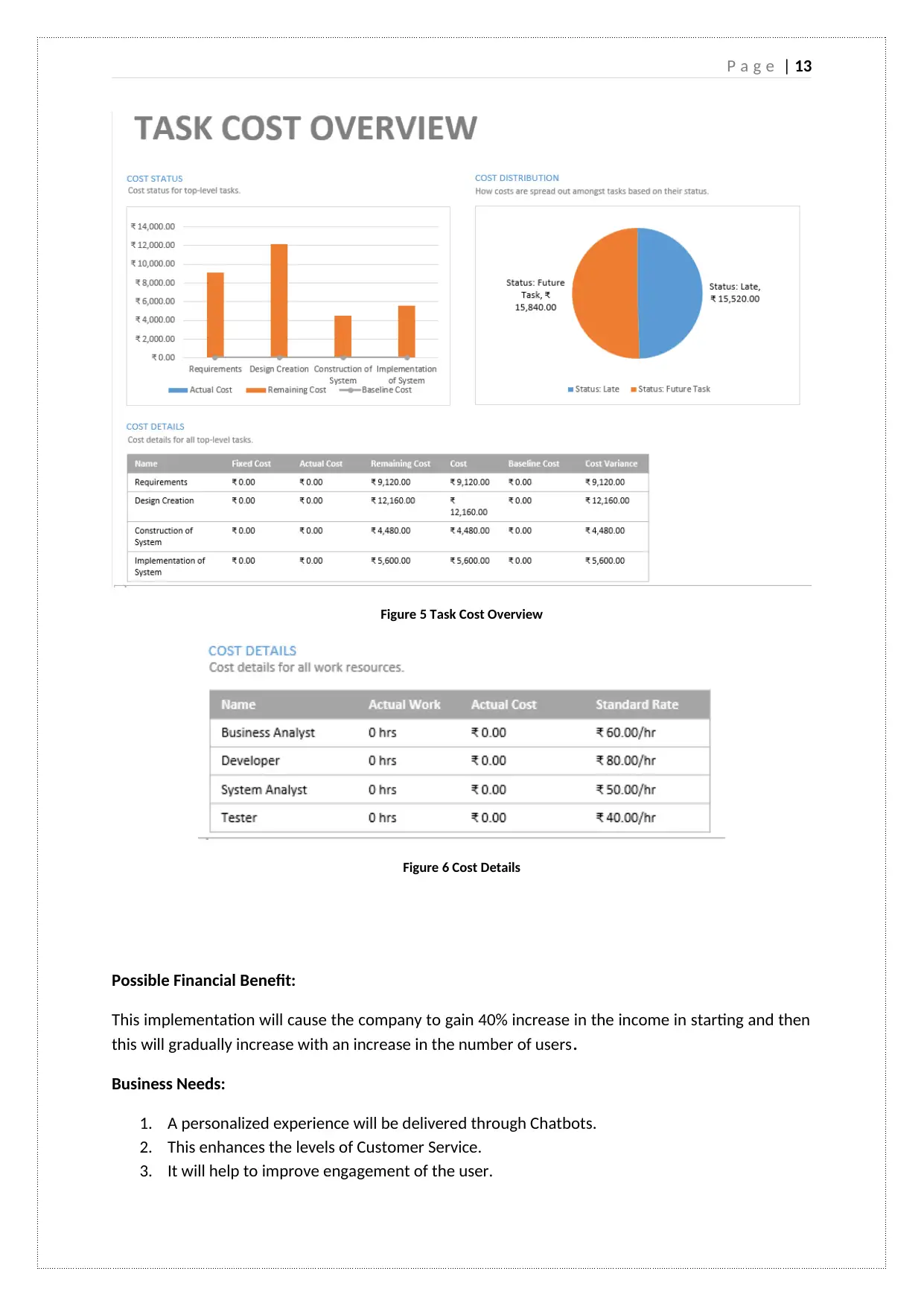
Figure 5 Task Cost Overview
Figure 6 Cost Details
Possible Financial Benefit:
This implementation will cause the company to gain 40% increase in the income in starting and then
this will gradually increase with an increase in the number of users.
Business Needs:
1. A personalized experience will be delivered through Chatbots.
2. This enhances the levels of Customer Service.
3. It will help to improve engagement of the user.
Paraphrase This Document
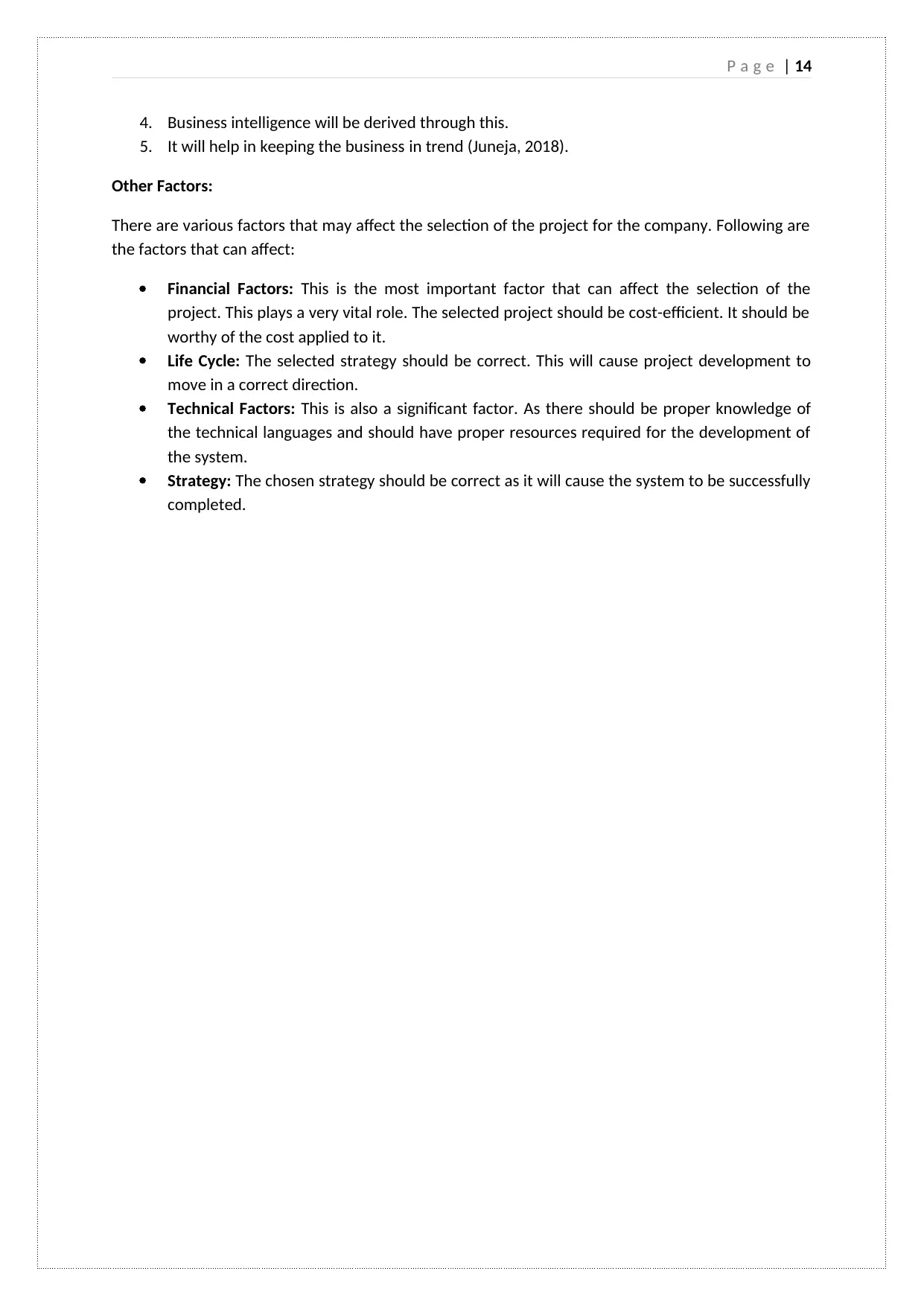
4. Business intelligence will be derived through this.
5. It will help in keeping the business in trend (Juneja, 2018).
Other Factors:
There are various factors that may affect the selection of the project for the company. Following are
the factors that can affect:
Financial Factors: This is the most important factor that can affect the selection of the
project. This plays a very vital role. The selected project should be cost-efficient. It should be
worthy of the cost applied to it.
Life Cycle: The selected strategy should be correct. This will cause project development to
move in a correct direction.
Technical Factors: This is also a significant factor. As there should be proper knowledge of
the technical languages and should have proper resources required for the development of
the system.
Strategy: The chosen strategy should be correct as it will cause the system to be successfully
completed.
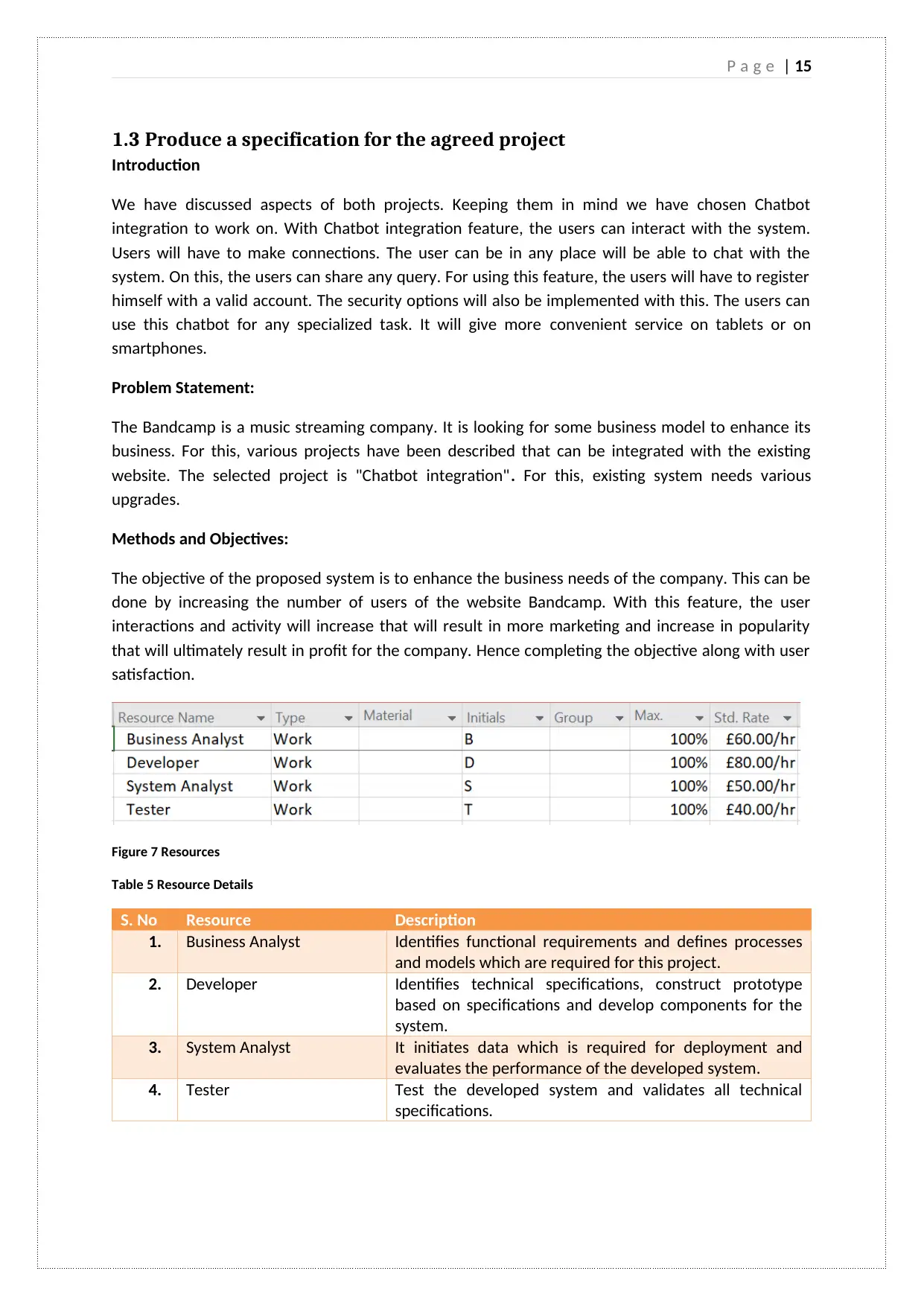
1.3 Produce a specification for the agreed project
Introduction
We have discussed aspects of both projects. Keeping them in mind we have chosen Chatbot
integration to work on. With Chatbot integration feature, the users can interact with the system.
Users will have to make connections. The user can be in any place will be able to chat with the
system. On this, the users can share any query. For using this feature, the users will have to register
himself with a valid account. The security options will also be implemented with this. The users can
use this chatbot for any specialized task. It will give more convenient service on tablets or on
smartphones.
Problem Statement:
The Bandcamp is a music streaming company. It is looking for some business model to enhance its
business. For this, various projects have been described that can be integrated with the existing
website. The selected project is "Chatbot integration". For this, existing system needs various
upgrades.
Methods and Objectives:
The objective of the proposed system is to enhance the business needs of the company. This can be
done by increasing the number of users of the website Bandcamp. With this feature, the user
interactions and activity will increase that will result in more marketing and increase in popularity
that will ultimately result in profit for the company. Hence completing the objective along with user
satisfaction.
Figure 7 Resources
Table 5 Resource Details
S. No Resource Description
1. Business Analyst Identifies functional requirements and defines processes
and models which are required for this project.
2. Developer Identifies technical specifications, construct prototype
based on specifications and develop components for the
system.
3. System Analyst It initiates data which is required for deployment and
evaluates the performance of the developed system.
4. Tester Test the developed system and validates all technical
specifications.
⊘ This is a preview!⊘
Do you want full access?
Subscribe today to unlock all pages.

Trusted by 1+ million students worldwide
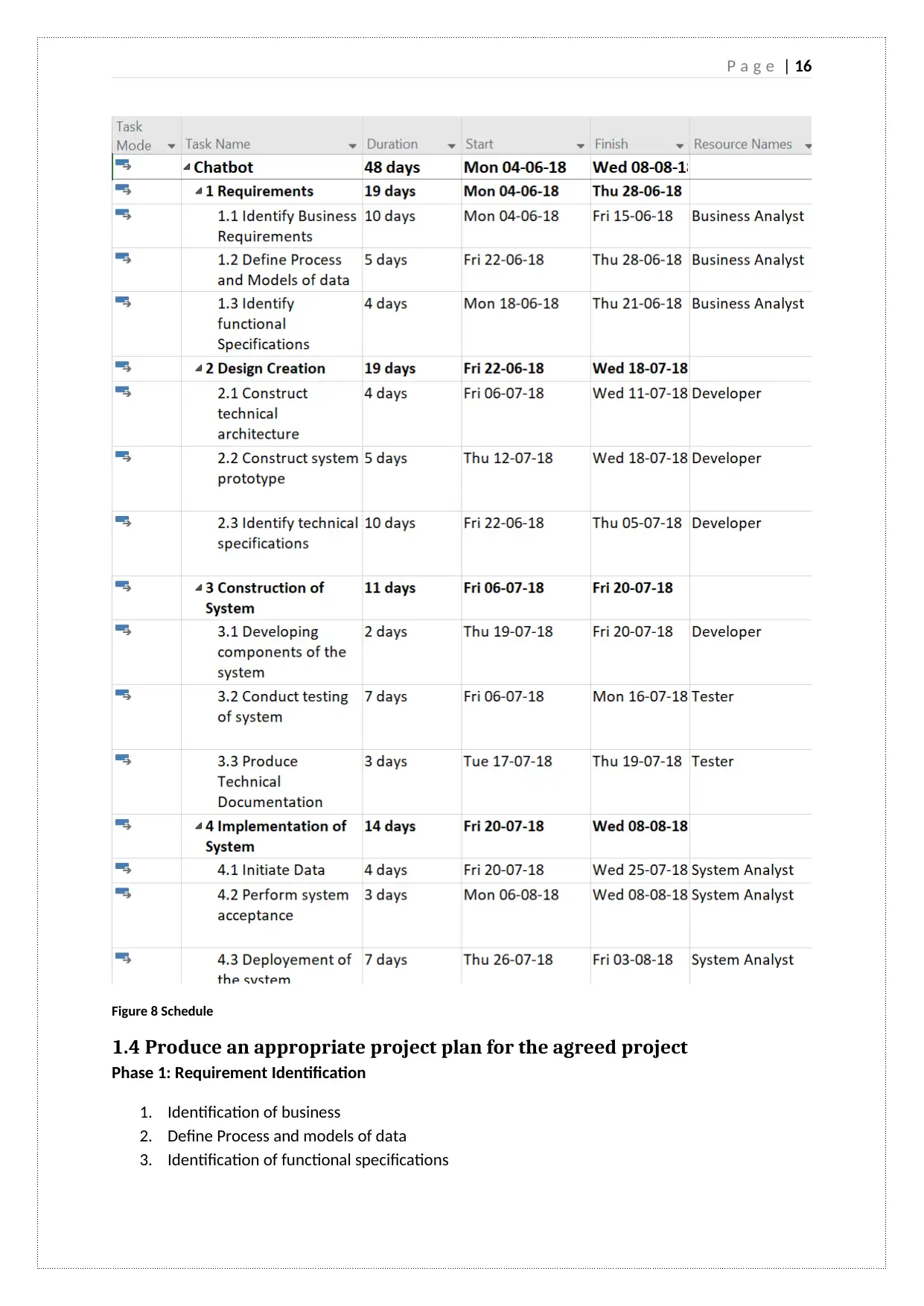
Figure 8 Schedule
1.4 Produce an appropriate project plan for the agreed project
Phase 1: Requirement Identification
1. Identification of business
2. Define Process and models of data
3. Identification of functional specifications
Paraphrase This Document
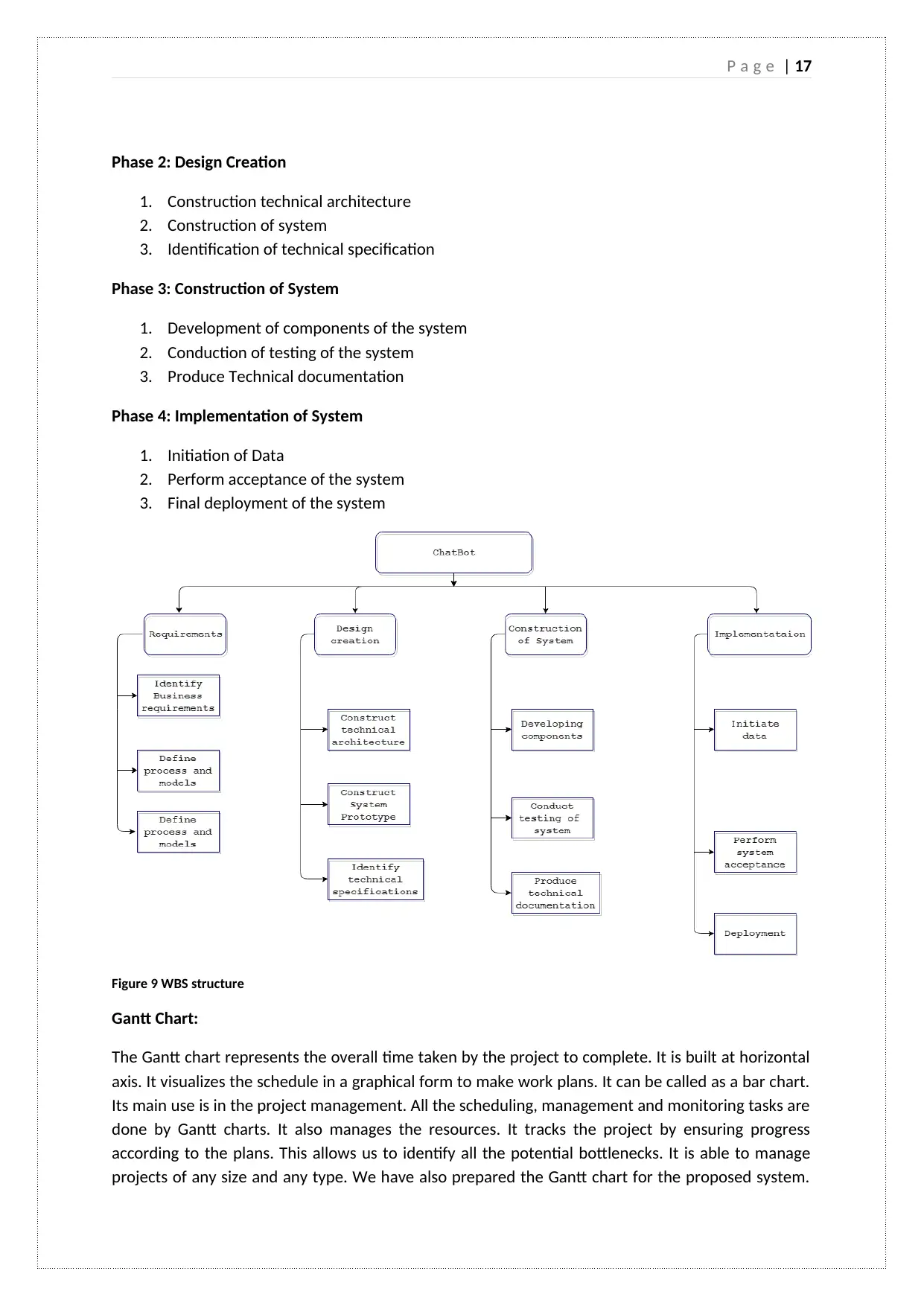
Phase 2: Design Creation
1. Construction technical architecture
2. Construction of system
3. Identification of technical specification
Phase 3: Construction of System
1. Development of components of the system
2. Conduction of testing of the system
3. Produce Technical documentation
Phase 4: Implementation of System
1. Initiation of Data
2. Perform acceptance of the system
3. Final deployment of the system
Figure 9 WBS structure
Gantt Chart:
The Gantt chart represents the overall time taken by the project to complete. It is built at horizontal
axis. It visualizes the schedule in a graphical form to make work plans. It can be called as a bar chart.
Its main use is in the project management. All the scheduling, management and monitoring tasks are
done by Gantt charts. It also manages the resources. It tracks the project by ensuring progress
according to the plans. This allows us to identify all the potential bottlenecks. It is able to manage
projects of any size and any type. We have also prepared the Gantt chart for the proposed system.
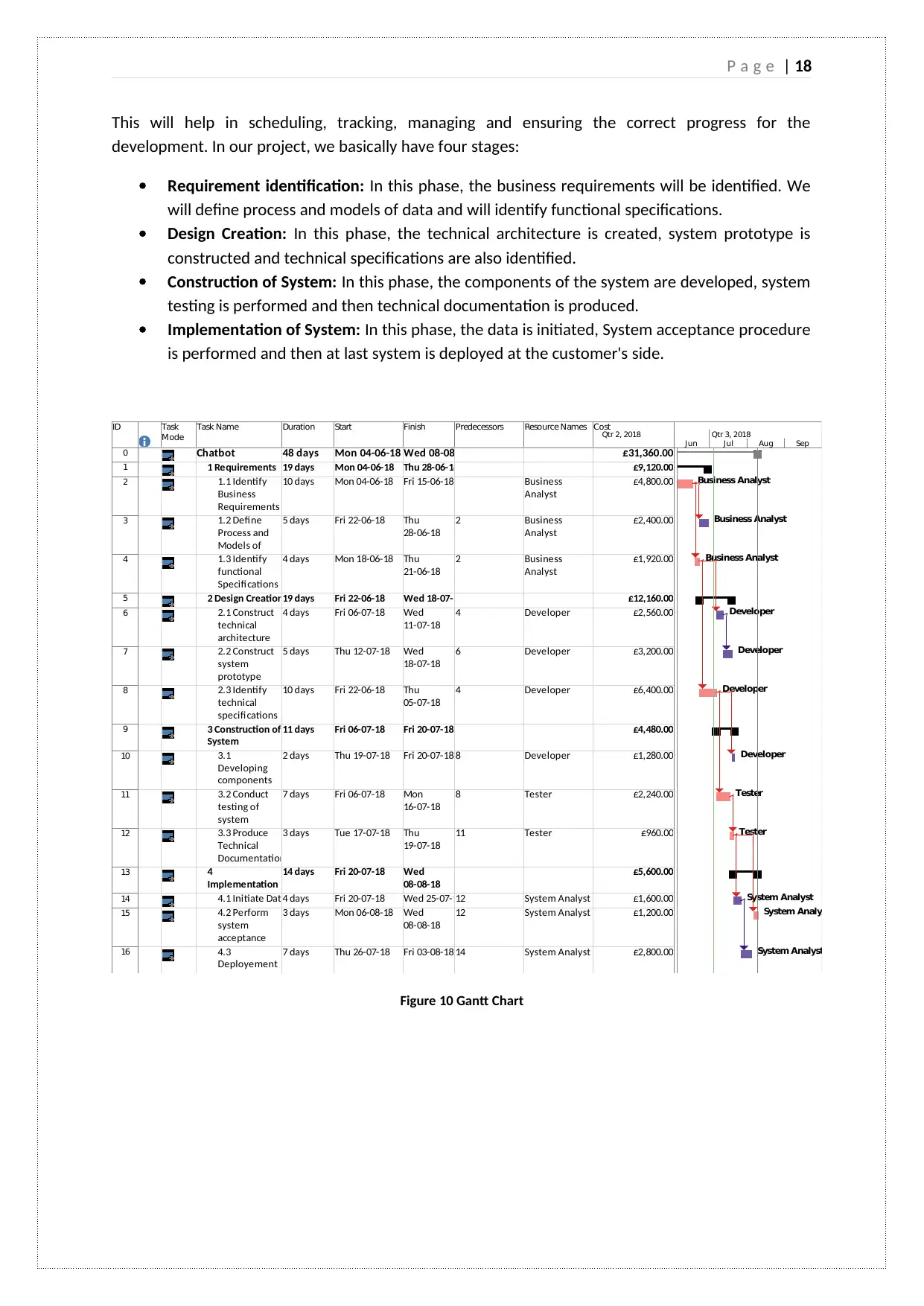
This will help in scheduling, tracking, managing and ensuring the correct progress for the
development. In our project, we basically have four stages:
Requirement identification: In this phase, the business requirements will be identified. We
will define process and models of data and will identify functional specifications.
Design Creation: In this phase, the technical architecture is created, system prototype is
constructed and technical specifications are also identified.
Construction of System: In this phase, the components of the system are developed, system
testing is performed and then technical documentation is produced.
Implementation of System: In this phase, the data is initiated, System acceptance procedure
is performed and then at last system is deployed at the customer's side.
ID Task
Mode
Task Name Duration Start Finish Predecessors Resource Names Cost
0 Chatbot 48 days Mon 04-06-18 Wed 08-08-18 £31,360.00
1 1 Requirements 19 days Mon 04-06-18 Thu 28-06-18 £9,120.00
2 1.1 Identify
Business
Requirements
10 days Mon 04-06-18 Fri 15-06-18 Business
Analyst
£4,800.00
3 1.2 Define
Process and
Models of
data
5 days Fri 22-06-18 Thu
28-06-18
2 Business
Analyst
£2,400.00
4 1.3 Identify
functional
Specifications
4 days Mon 18-06-18 Thu
21-06-18
2 Business
Analyst
£1,920.00
5 2 Design Creation19 days Fri 22-06-18 Wed 18-07-18 £12,160.00
6 2.1 Construct
technical
architecture
4 days Fri 06-07-18 Wed
11-07-18
4 Developer £2,560.00
7 2.2 Construct
system
prototype
5 days Thu 12-07-18 Wed
18-07-18
6 Developer £3,200.00
8 2.3 Identify
technical
specifications
10 days Fri 22-06-18 Thu
05-07-18
4 Developer £6,400.00
9 3 Construction of
System
11 days Fri 06-07-18 Fri 20-07-18 £4,480.00
10 3.1
Developing
components
of the system
2 days Thu 19-07-18 Fri 20-07-18 8 Developer £1,280.00
11 3.2 Conduct
testing of
system
7 days Fri 06-07-18 Mon
16-07-18
8 Tester £2,240.00
12 3.3 Produce
Technical
Documentation
3 days Tue 17-07-18 Thu
19-07-18
11 Tester £960.00
13 4
Implementation
of System
14 days Fri 20-07-18 Wed
08-08-18
£5,600.00
14 4.1 Initiate Data4 days Fri 20-07-18 Wed 25-07-1812 System Analyst £1,600.00
15 4.2 Perform
system
acceptance
3 days Mon 06-08-18 Wed
08-08-18
12 System Analyst £1,200.00
16 4.3
Deployement
of the system
7 days Thu 26-07-18 Fri 03-08-18 14 System Analyst £2,800.00
Business Analyst
Business Analyst
Business Analyst
Developer
Developer
Developer
Developer
Tester
Tester
System Analyst
System Analyst
System Analyst
Jun Jul Aug Sep Oct
Qtr 2, 2018 Qtr 3, 2018
Figure 10 Gantt Chart
⊘ This is a preview!⊘
Do you want full access?
Subscribe today to unlock all pages.

Trusted by 1+ million students worldwide

Figure 11 Phase 1 Table
Figure 12 Phase 2 Table
Figure 13 Phase 3 Table
Figure 14 Phase 4 table
Paraphrase This Document

Figure 15 task cost
Figure 16 Resource cost
Figure 17 cost status
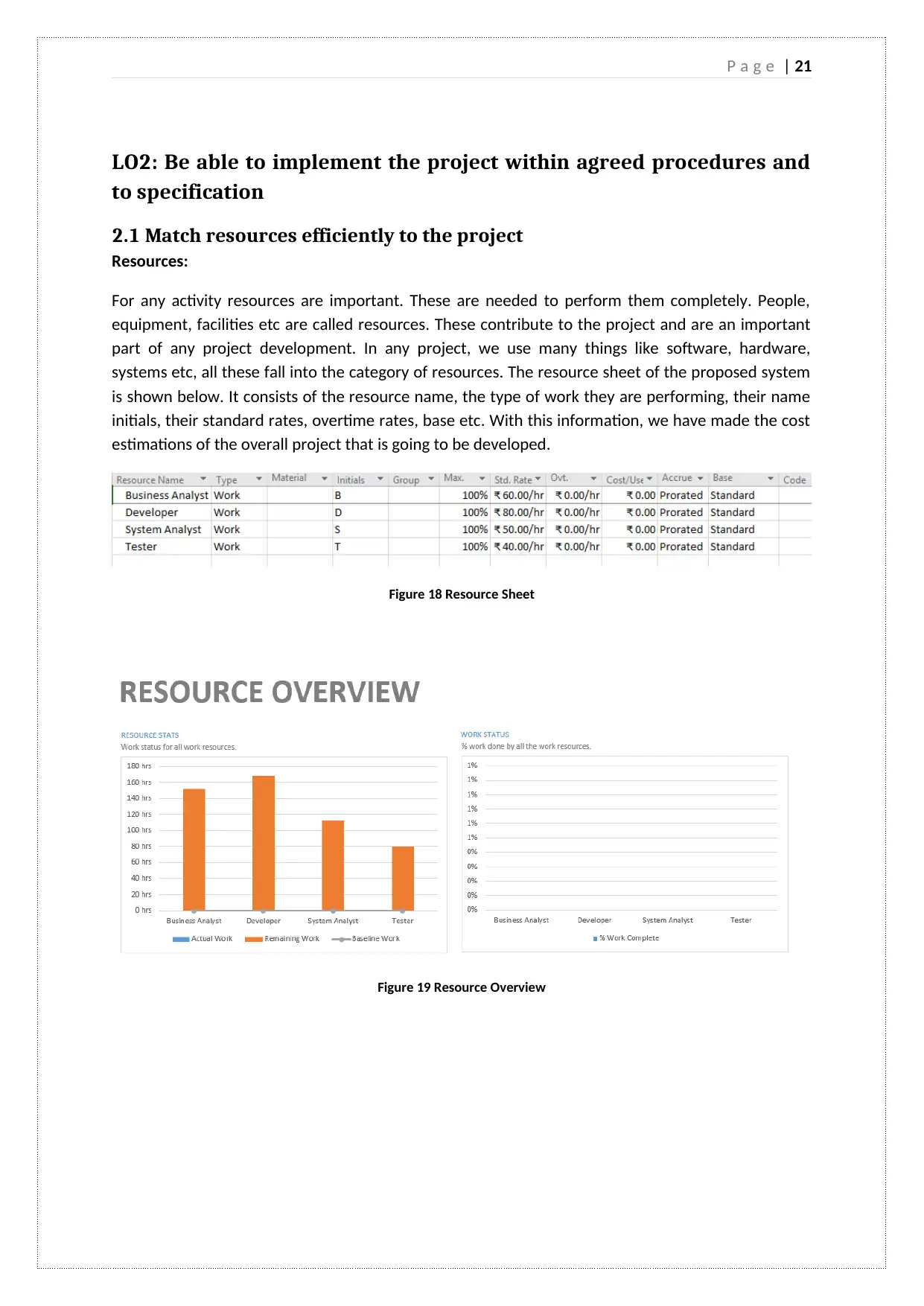
LO2: Be able to implement the project within agreed procedures and
to specification
2.1 Match resources efficiently to the project
Resources:
For any activity resources are important. These are needed to perform them completely. People,
equipment, facilities etc are called resources. These contribute to the project and are an important
part of any project development. In any project, we use many things like software, hardware,
systems etc, all these fall into the category of resources. The resource sheet of the proposed system
is shown below. It consists of the resource name, the type of work they are performing, their name
initials, their standard rates, overtime rates, base etc. With this information, we have made the cost
estimations of the overall project that is going to be developed.
Figure 18 Resource Sheet
Figure 19 Resource Overview
⊘ This is a preview!⊘
Do you want full access?
Subscribe today to unlock all pages.

Trusted by 1+ million students worldwide
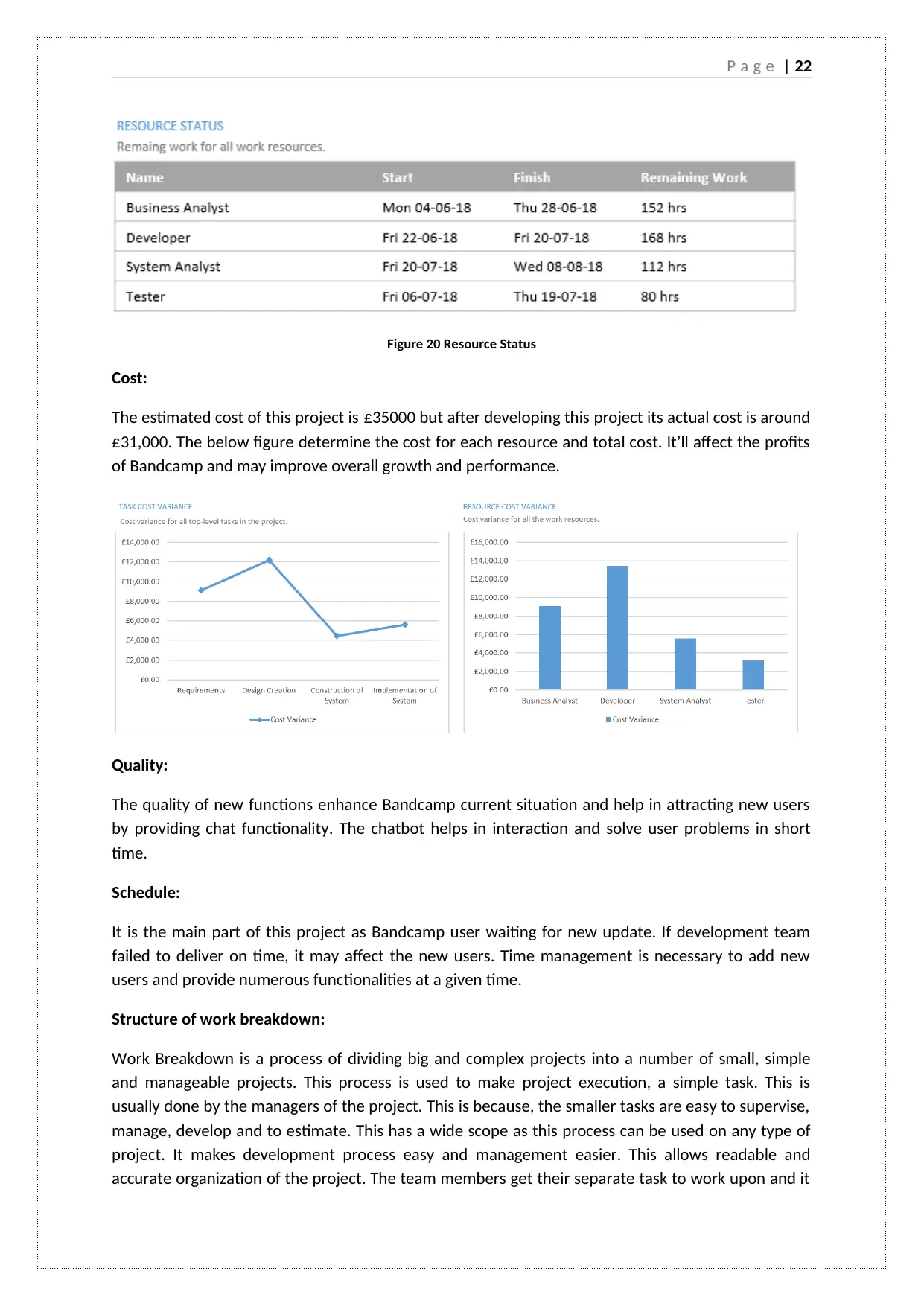
Figure 20 Resource Status
Cost:
The estimated cost of this project is £35000 but after developing this project its actual cost is around
£31,000. The below figure determine the cost for each resource and total cost. It’ll affect the profits
of Bandcamp and may improve overall growth and performance.
Quality:
The quality of new functions enhance Bandcamp current situation and help in attracting new users
by providing chat functionality. The chatbot helps in interaction and solve user problems in short
time.
Schedule:
It is the main part of this project as Bandcamp user waiting for new update. If development team
failed to deliver on time, it may affect the new users. Time management is necessary to add new
users and provide numerous functionalities at a given time.
Structure of work breakdown:
Work Breakdown is a process of dividing big and complex projects into a number of small, simple
and manageable projects. This process is used to make project execution, a simple task. This is
usually done by the managers of the project. This is because, the smaller tasks are easy to supervise,
manage, develop and to estimate. This has a wide scope as this process can be used on any type of
project. It makes development process easy and management easier. This allows readable and
accurate organization of the project. The team members get their separate task to work upon and it
Paraphrase This Document
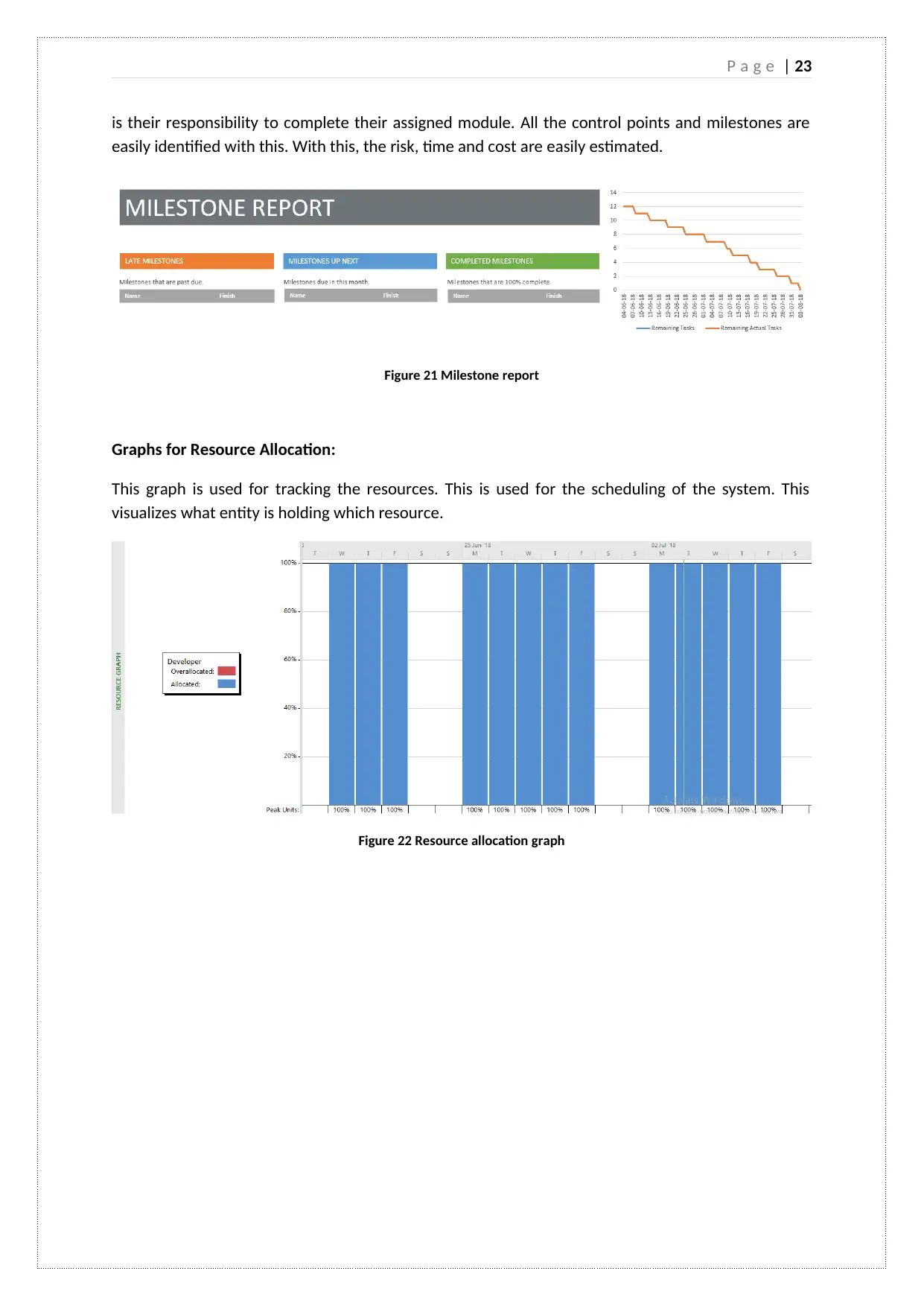
is their responsibility to complete their assigned module. All the control points and milestones are
easily identified with this. With this, the risk, time and cost are easily estimated.
Figure 21 Milestone report
Graphs for Resource Allocation:
This graph is used for tracking the resources. This is used for the scheduling of the system. This
visualizes what entity is holding which resource.
Figure 22 Resource allocation graph
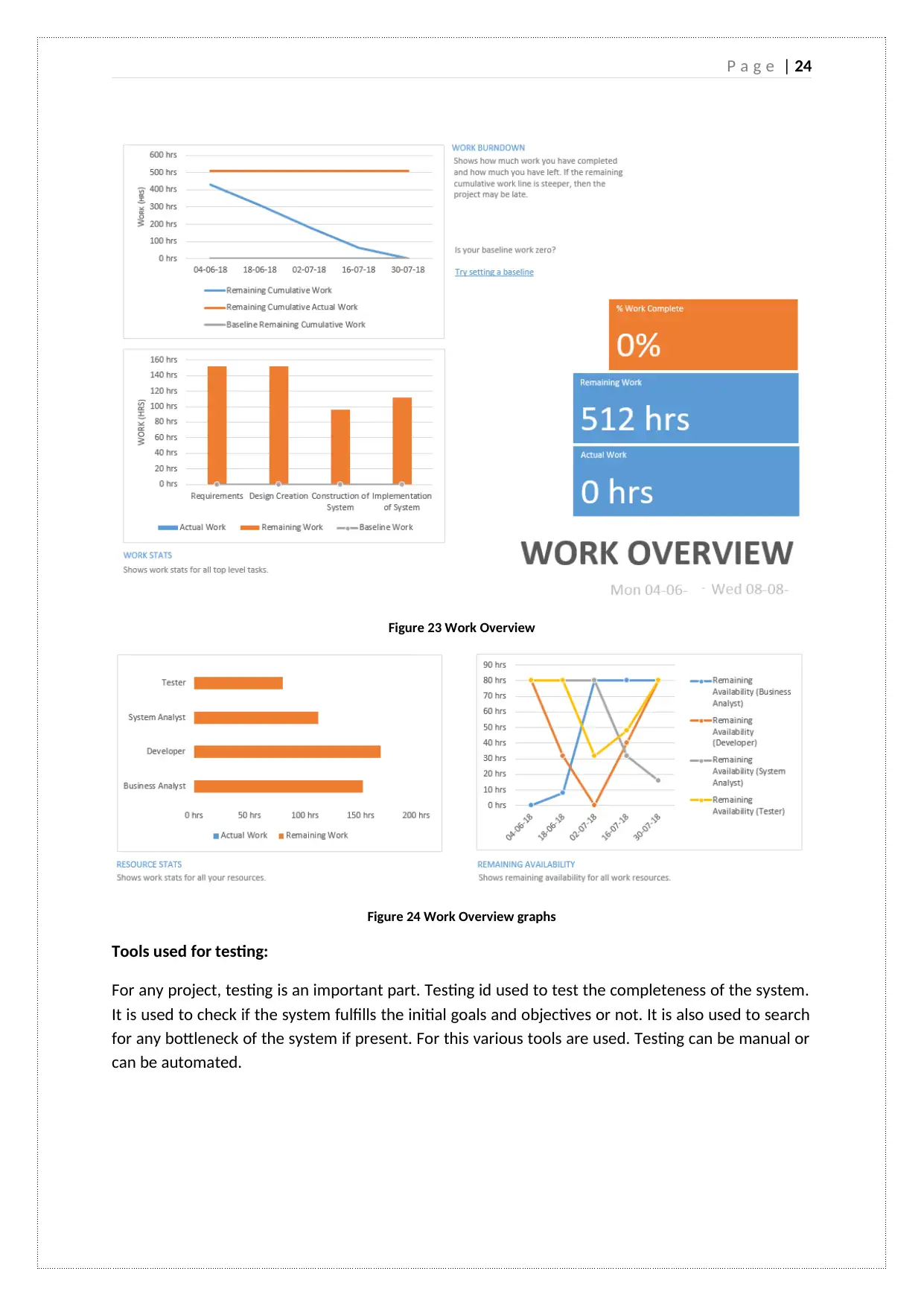
Figure 23 Work Overview
Figure 24 Work Overview graphs
Tools used for testing:
For any project, testing is an important part. Testing id used to test the completeness of the system.
It is used to check if the system fulfills the initial goals and objectives or not. It is also used to search
for any bottleneck of the system if present. For this various tools are used. Testing can be manual or
can be automated.
⊘ This is a preview!⊘
Do you want full access?
Subscribe today to unlock all pages.

Trusted by 1+ million students worldwide
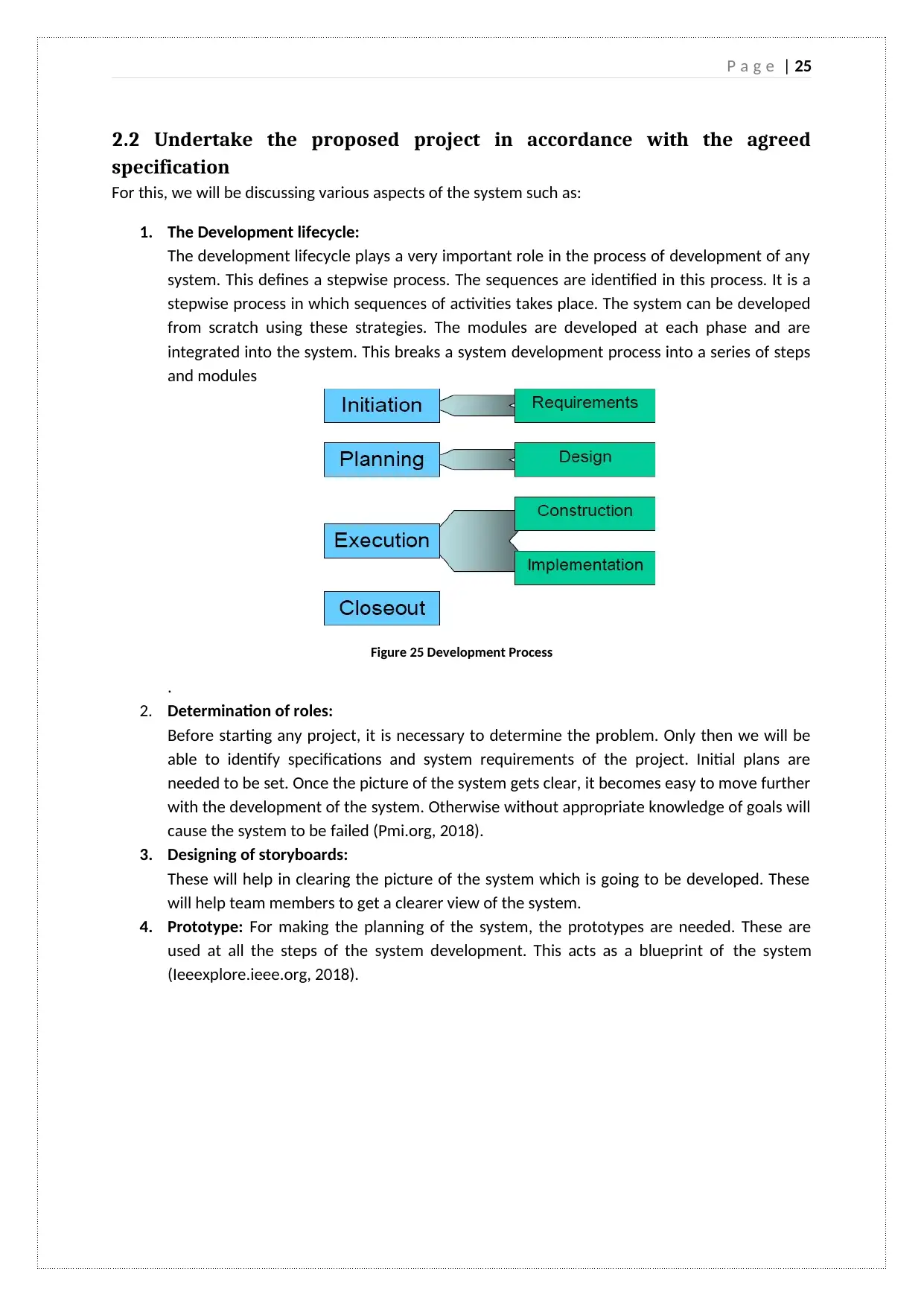
2.2 Undertake the proposed project in accordance with the agreed
specification
For this, we will be discussing various aspects of the system such as:
1. The Development lifecycle:
The development lifecycle plays a very important role in the process of development of any
system. This defines a stepwise process. The sequences are identified in this process. It is a
stepwise process in which sequences of activities takes place. The system can be developed
from scratch using these strategies. The modules are developed at each phase and are
integrated into the system. This breaks a system development process into a series of steps
and modules
Figure 25 Development Process
.
2. Determination of roles:
Before starting any project, it is necessary to determine the problem. Only then we will be
able to identify specifications and system requirements of the project. Initial plans are
needed to be set. Once the picture of the system gets clear, it becomes easy to move further
with the development of the system. Otherwise without appropriate knowledge of goals will
cause the system to be failed (Pmi.org, 2018).
3. Designing of storyboards:
These will help in clearing the picture of the system which is going to be developed. These
will help team members to get a clearer view of the system.
4. Prototype: For making the planning of the system, the prototypes are needed. These are
used at all the steps of the system development. This acts as a blueprint of the system
(Ieeexplore.ieee.org, 2018).
Paraphrase This Document
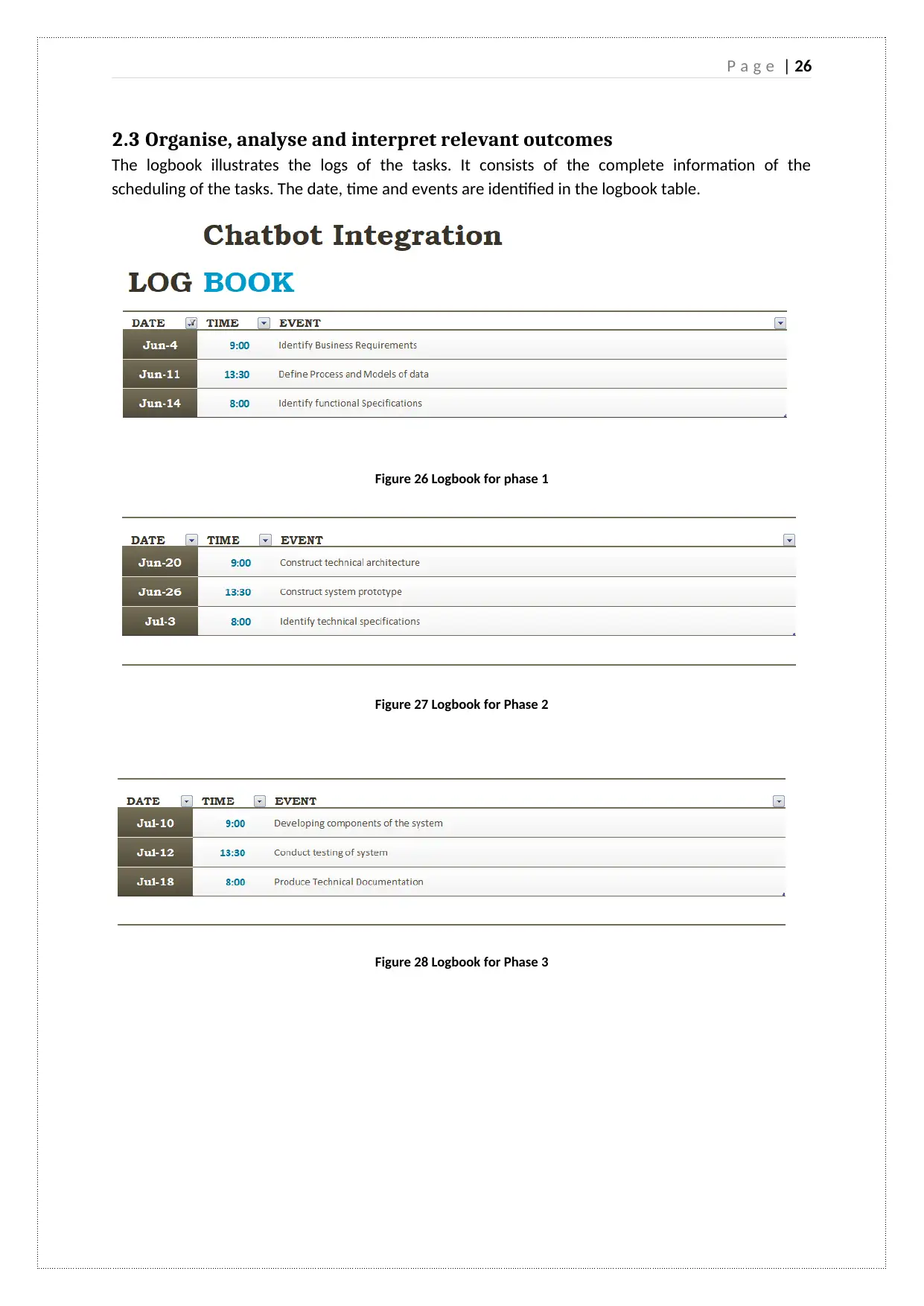
2.3 Organise, analyse and interpret relevant outcomes
The logbook illustrates the logs of the tasks. It consists of the complete information of the
scheduling of the tasks. The date, time and events are identified in the logbook table.
Figure 26 Logbook for phase 1
Figure 27 Logbook for Phase 2
Figure 28 Logbook for Phase 3
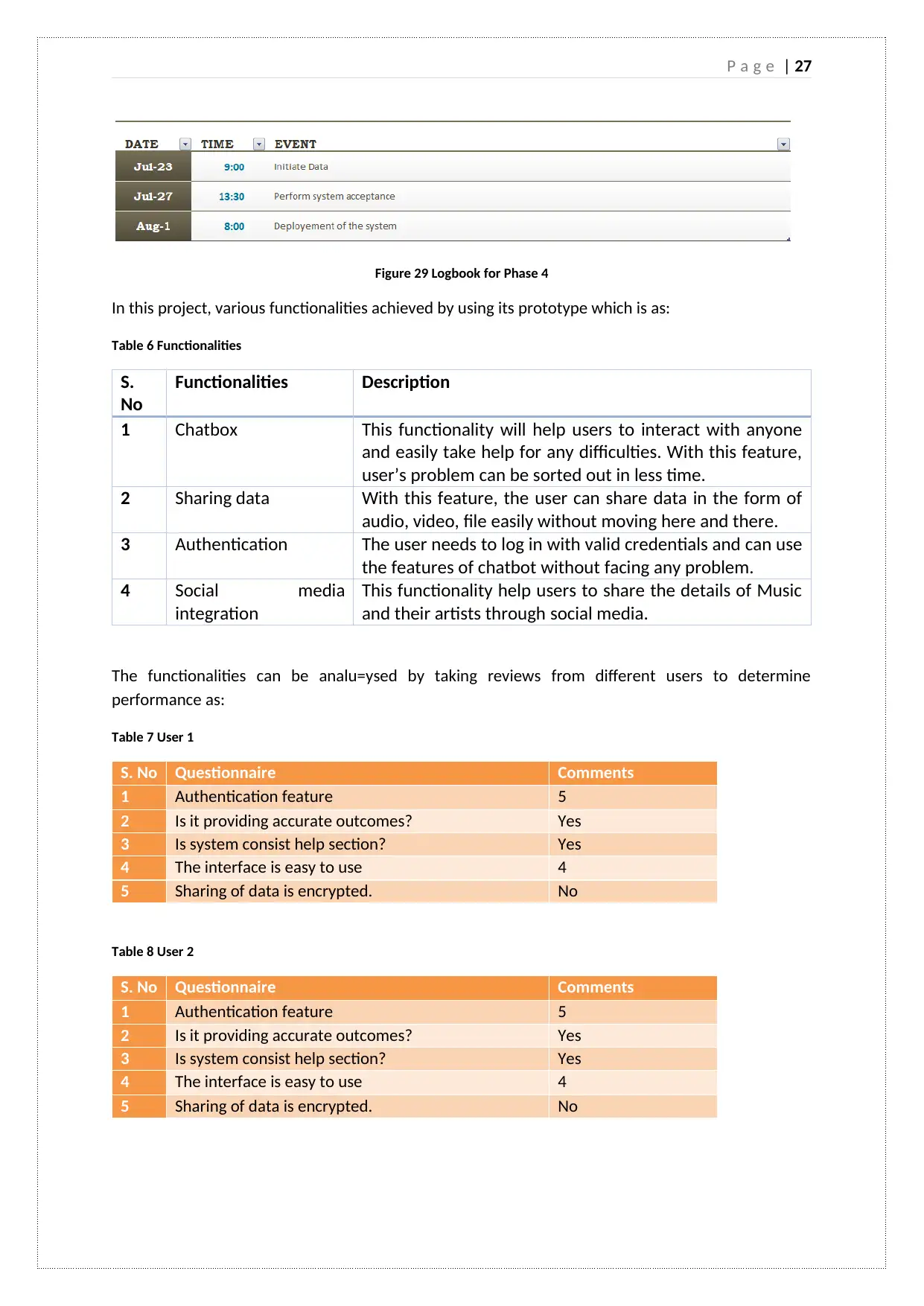
Figure 29 Logbook for Phase 4
In this project, various functionalities achieved by using its prototype which is as:
Table 6 Functionalities
S.
No
Functionalities Description
1 Chatbox This functionality will help users to interact with anyone
and easily take help for any difficulties. With this feature,
user’s problem can be sorted out in less time.
2 Sharing data With this feature, the user can share data in the form of
audio, video, file easily without moving here and there.
3 Authentication The user needs to log in with valid credentials and can use
the features of chatbot without facing any problem.
4 Social media
integration
This functionality help users to share the details of Music
and their artists through social media.
The functionalities can be analu=ysed by taking reviews from different users to determine
performance as:
Table 7 User 1
S. No Questionnaire Comments
1 Authentication feature 5
2 Is it providing accurate outcomes? Yes
3 Is system consist help section? Yes
4 The interface is easy to use 4
5 Sharing of data is encrypted. No
Table 8 User 2
S. No Questionnaire Comments
1 Authentication feature 5
2 Is it providing accurate outcomes? Yes
3 Is system consist help section? Yes
4 The interface is easy to use 4
5 Sharing of data is encrypted. No
⊘ This is a preview!⊘
Do you want full access?
Subscribe today to unlock all pages.

Trusted by 1+ million students worldwide
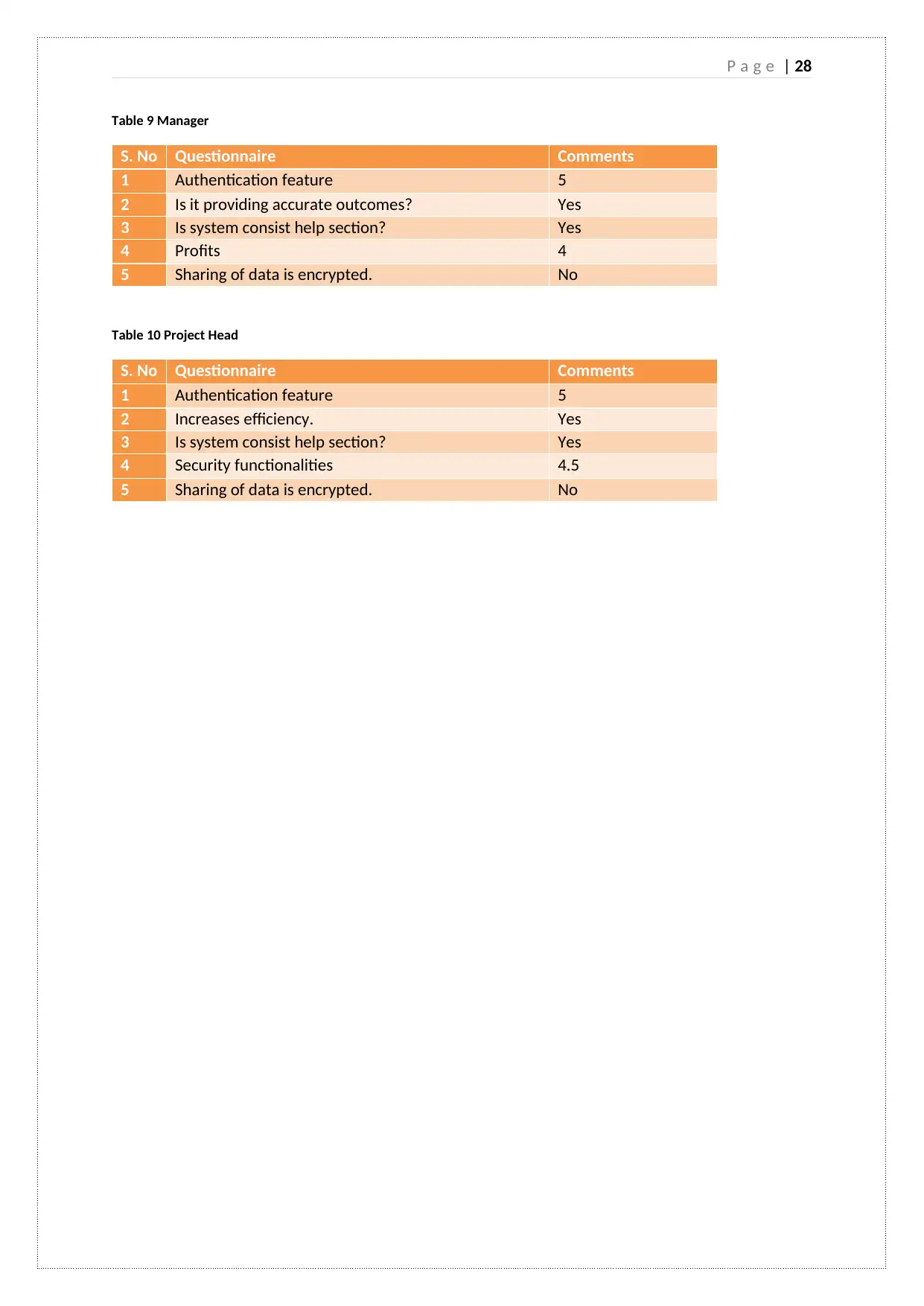
Table 9 Manager
S. No Questionnaire Comments
1 Authentication feature 5
2 Is it providing accurate outcomes? Yes
3 Is system consist help section? Yes
4 Profits 4
5 Sharing of data is encrypted. No
Table 10 Project Head
S. No Questionnaire Comments
1 Authentication feature 5
2 Increases efficiency. Yes
3 Is system consist help section? Yes
4 Security functionalities 4.5
5 Sharing of data is encrypted. No
Paraphrase This Document
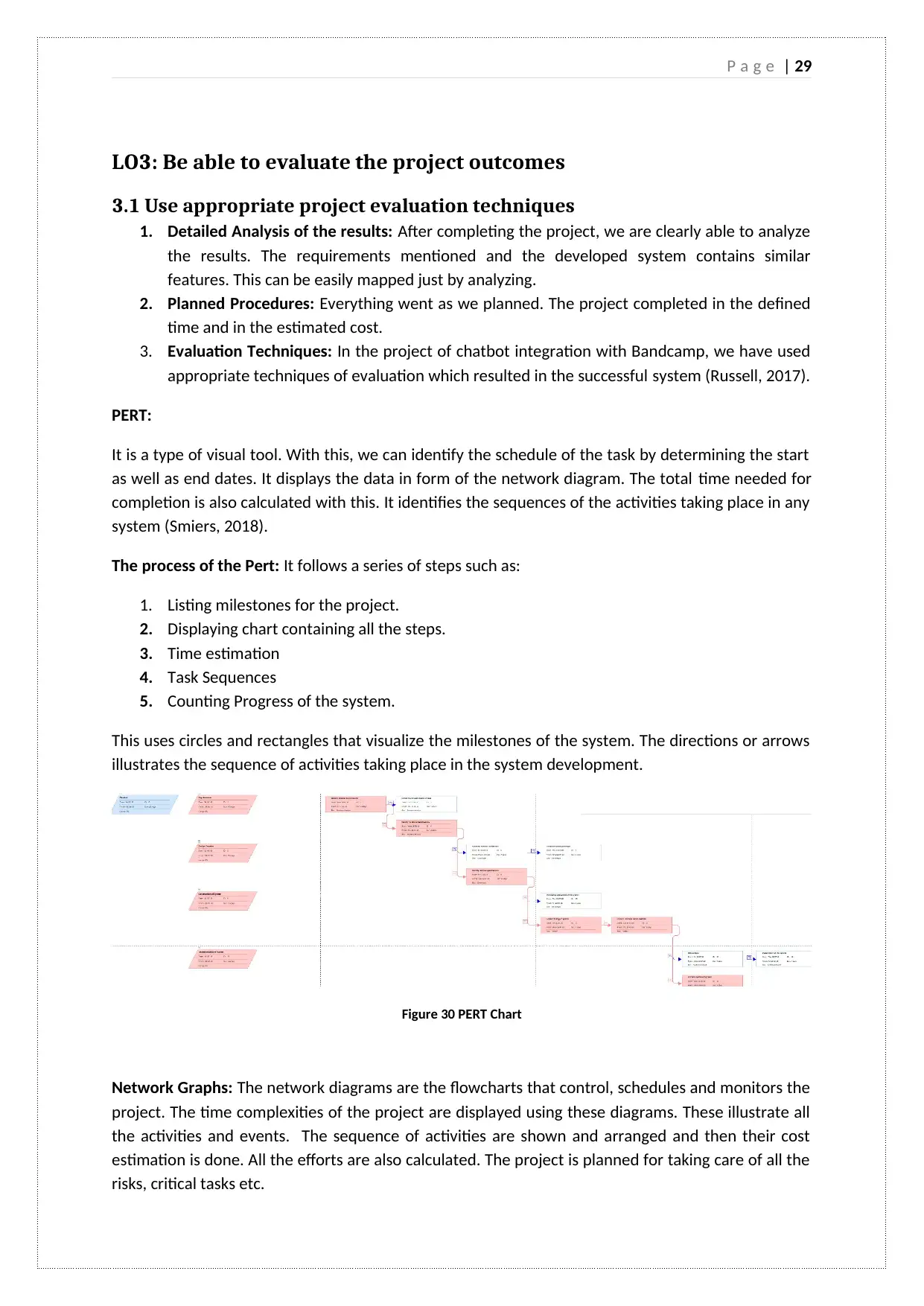
LO3: Be able to evaluate the project outcomes
3.1 Use appropriate project evaluation techniques
1. Detailed Analysis of the results: After completing the project, we are clearly able to analyze
the results. The requirements mentioned and the developed system contains similar
features. This can be easily mapped just by analyzing.
2. Planned Procedures: Everything went as we planned. The project completed in the defined
time and in the estimated cost.
3. Evaluation Techniques: In the project of chatbot integration with Bandcamp, we have used
appropriate techniques of evaluation which resulted in the successful system (Russell, 2017).
PERT:
It is a type of visual tool. With this, we can identify the schedule of the task by determining the start
as well as end dates. It displays the data in form of the network diagram. The total time needed for
completion is also calculated with this. It identifies the sequences of the activities taking place in any
system (Smiers, 2018).
The process of the Pert: It follows a series of steps such as:
1. Listing milestones for the project.
2. Displaying chart containing all the steps.
3. Time estimation
4. Task Sequences
5. Counting Progress of the system.
This uses circles and rectangles that visualize the milestones of the system. The directions or arrows
illustrates the sequence of activities taking place in the system development.
Figure 30 PERT Chart
Network Graphs: The network diagrams are the flowcharts that control, schedules and monitors the
project. The time complexities of the project are displayed using these diagrams. These illustrate all
the activities and events. The sequence of activities are shown and arranged and then their cost
estimation is done. All the efforts are also calculated. The project is planned for taking care of all the
risks, critical tasks etc.
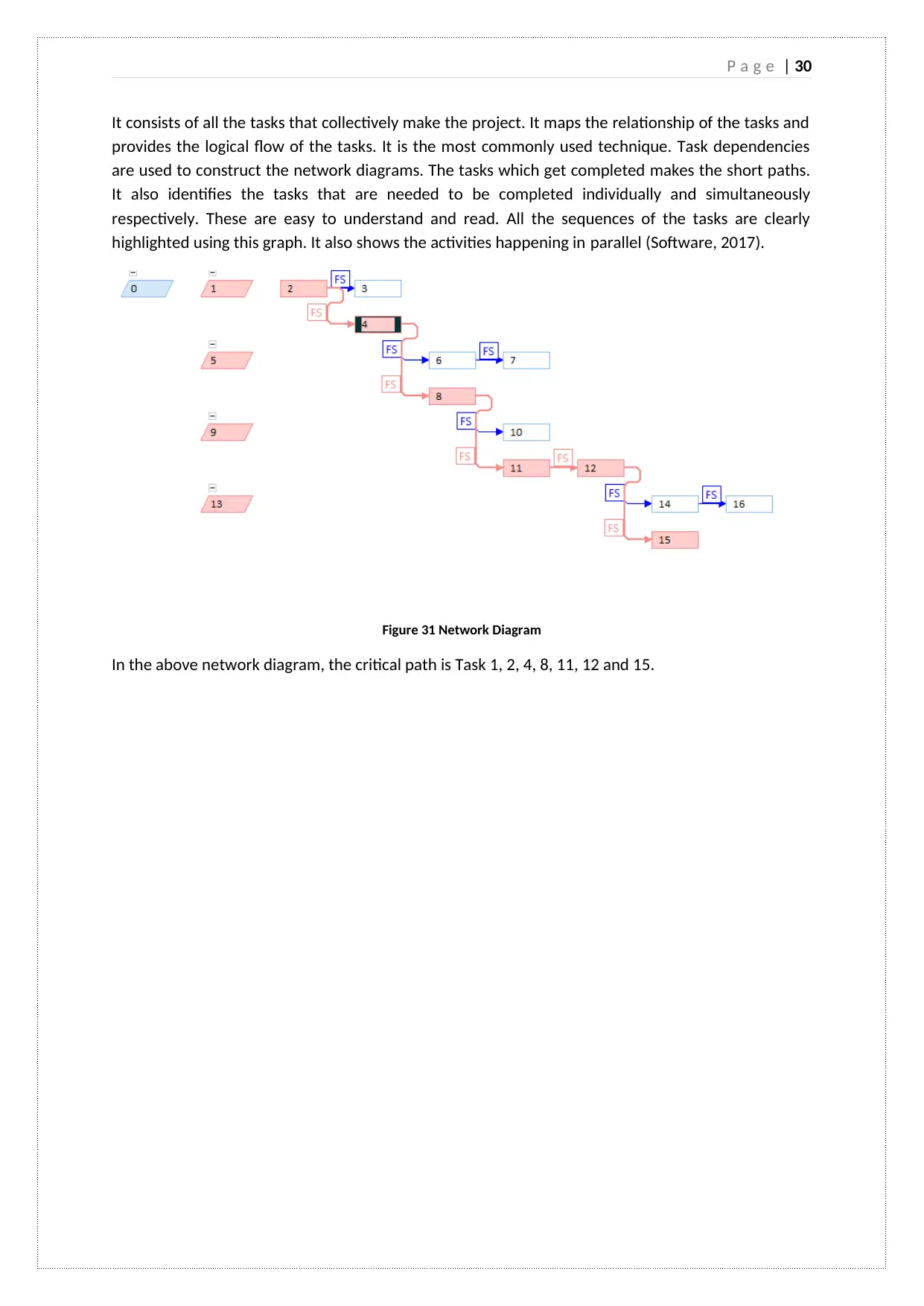
It consists of all the tasks that collectively make the project. It maps the relationship of the tasks and
provides the logical flow of the tasks. It is the most commonly used technique. Task dependencies
are used to construct the network diagrams. The tasks which get completed makes the short paths.
It also identifies the tasks that are needed to be completed individually and simultaneously
respectively. These are easy to understand and read. All the sequences of the tasks are clearly
highlighted using this graph. It also shows the activities happening in parallel (Software, 2017).
Figure 31 Network Diagram
In the above network diagram, the critical path is Task 1, 2, 4, 8, 11, 12 and 15.
⊘ This is a preview!⊘
Do you want full access?
Subscribe today to unlock all pages.

Trusted by 1+ million students worldwide
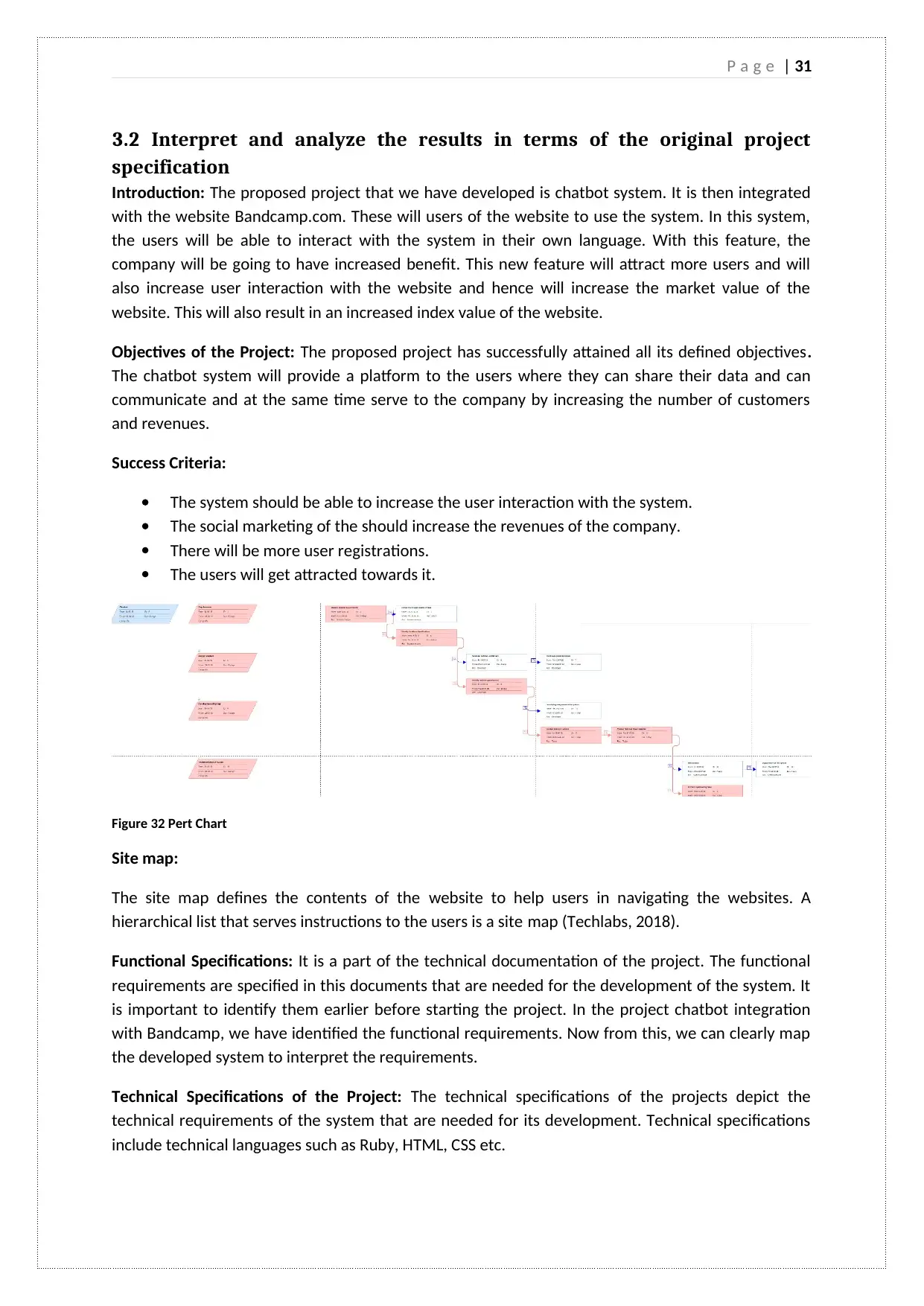
3.2 Interpret and analyze the results in terms of the original project
specification
Introduction: The proposed project that we have developed is chatbot system. It is then integrated
with the website Bandcamp.com. These will users of the website to use the system. In this system,
the users will be able to interact with the system in their own language. With this feature, the
company will be going to have increased benefit. This new feature will attract more users and will
also increase user interaction with the website and hence will increase the market value of the
website. This will also result in an increased index value of the website.
Objectives of the Project: The proposed project has successfully attained all its defined objectives.
The chatbot system will provide a platform to the users where they can share their data and can
communicate and at the same time serve to the company by increasing the number of customers
and revenues.
Success Criteria:
The system should be able to increase the user interaction with the system.
The social marketing of the should increase the revenues of the company.
There will be more user registrations.
The users will get attracted towards it.
Figure 32 Pert Chart
Site map:
The site map defines the contents of the website to help users in navigating the websites. A
hierarchical list that serves instructions to the users is a site map (Techlabs, 2018).
Functional Specifications: It is a part of the technical documentation of the project. The functional
requirements are specified in this documents that are needed for the development of the system. It
is important to identify them earlier before starting the project. In the project chatbot integration
with Bandcamp, we have identified the functional requirements. Now from this, we can clearly map
the developed system to interpret the requirements.
Technical Specifications of the Project: The technical specifications of the projects depict the
technical requirements of the system that are needed for its development. Technical specifications
include technical languages such as Ruby, HTML, CSS etc.
Paraphrase This Document
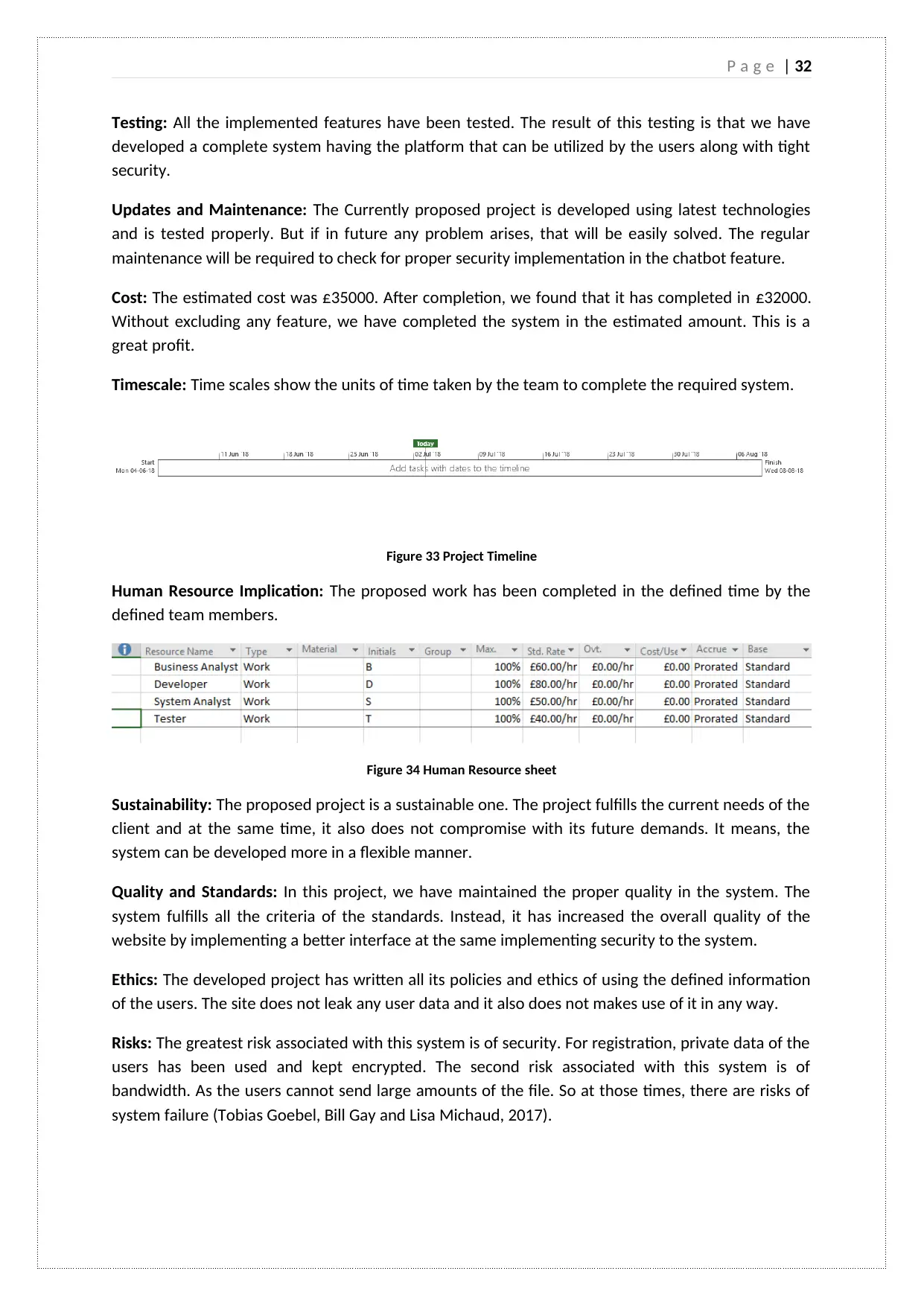
Testing: All the implemented features have been tested. The result of this testing is that we have
developed a complete system having the platform that can be utilized by the users along with tight
security.
Updates and Maintenance: The Currently proposed project is developed using latest technologies
and is tested properly. But if in future any problem arises, that will be easily solved. The regular
maintenance will be required to check for proper security implementation in the chatbot feature.
Cost: The estimated cost was £35000. After completion, we found that it has completed in £32000.
Without excluding any feature, we have completed the system in the estimated amount. This is a
great profit.
Timescale: Time scales show the units of time taken by the team to complete the required system.
Figure 33 Project Timeline
Human Resource Implication: The proposed work has been completed in the defined time by the
defined team members.
Figure 34 Human Resource sheet
Sustainability: The proposed project is a sustainable one. The project fulfills the current needs of the
client and at the same time, it also does not compromise with its future demands. It means, the
system can be developed more in a flexible manner.
Quality and Standards: In this project, we have maintained the proper quality in the system. The
system fulfills all the criteria of the standards. Instead, it has increased the overall quality of the
website by implementing a better interface at the same implementing security to the system.
Ethics: The developed project has written all its policies and ethics of using the defined information
of the users. The site does not leak any user data and it also does not makes use of it in any way.
Risks: The greatest risk associated with this system is of security. For registration, private data of the
users has been used and kept encrypted. The second risk associated with this system is of
bandwidth. As the users cannot send large amounts of the file. So at those times, there are risks of
system failure (Tobias Goebel, Bill Gay and Lisa Michaud, 2017).
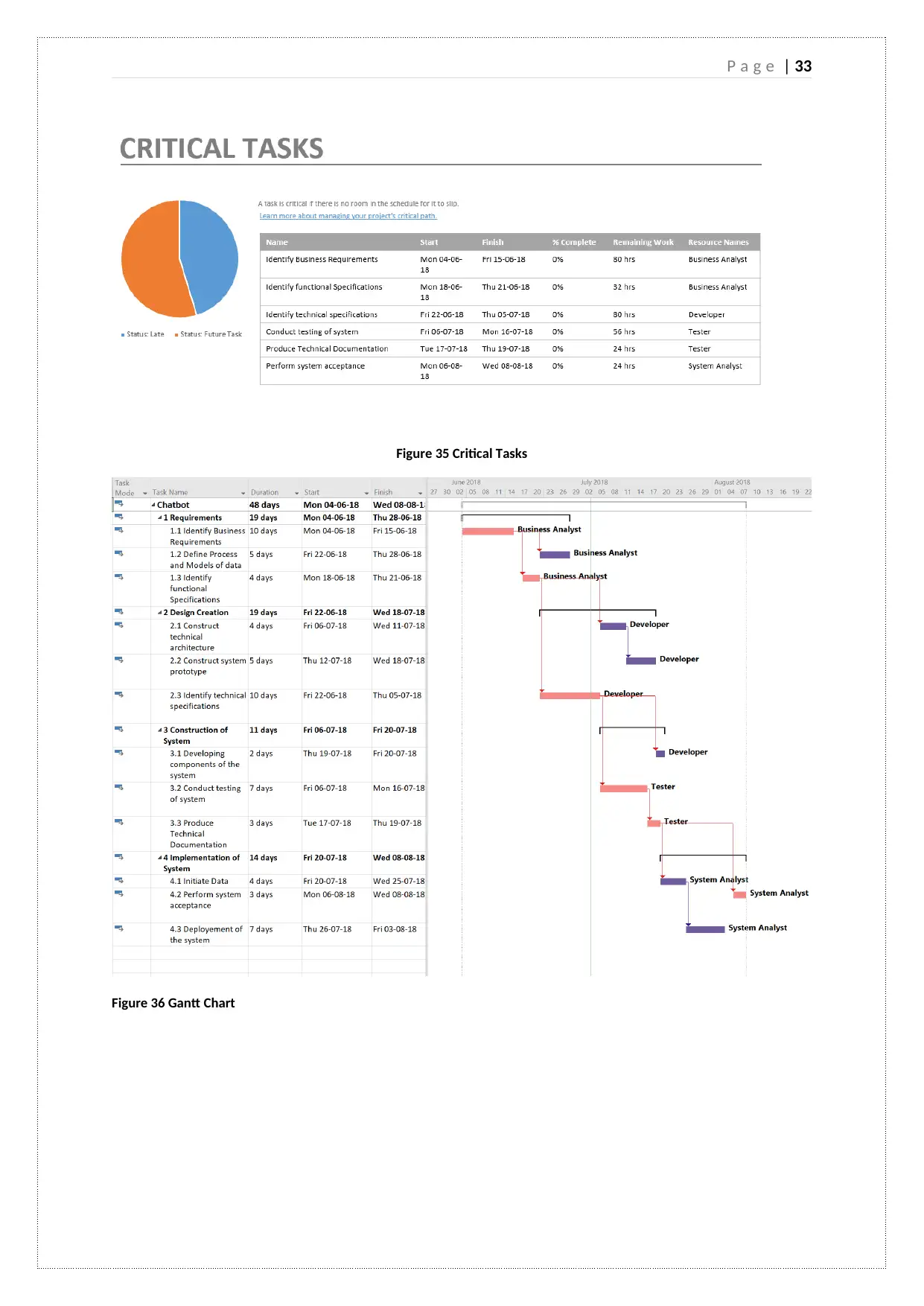
Figure 35 Critical Tasks
Figure 36 Gantt Chart
⊘ This is a preview!⊘
Do you want full access?
Subscribe today to unlock all pages.

Trusted by 1+ million students worldwide
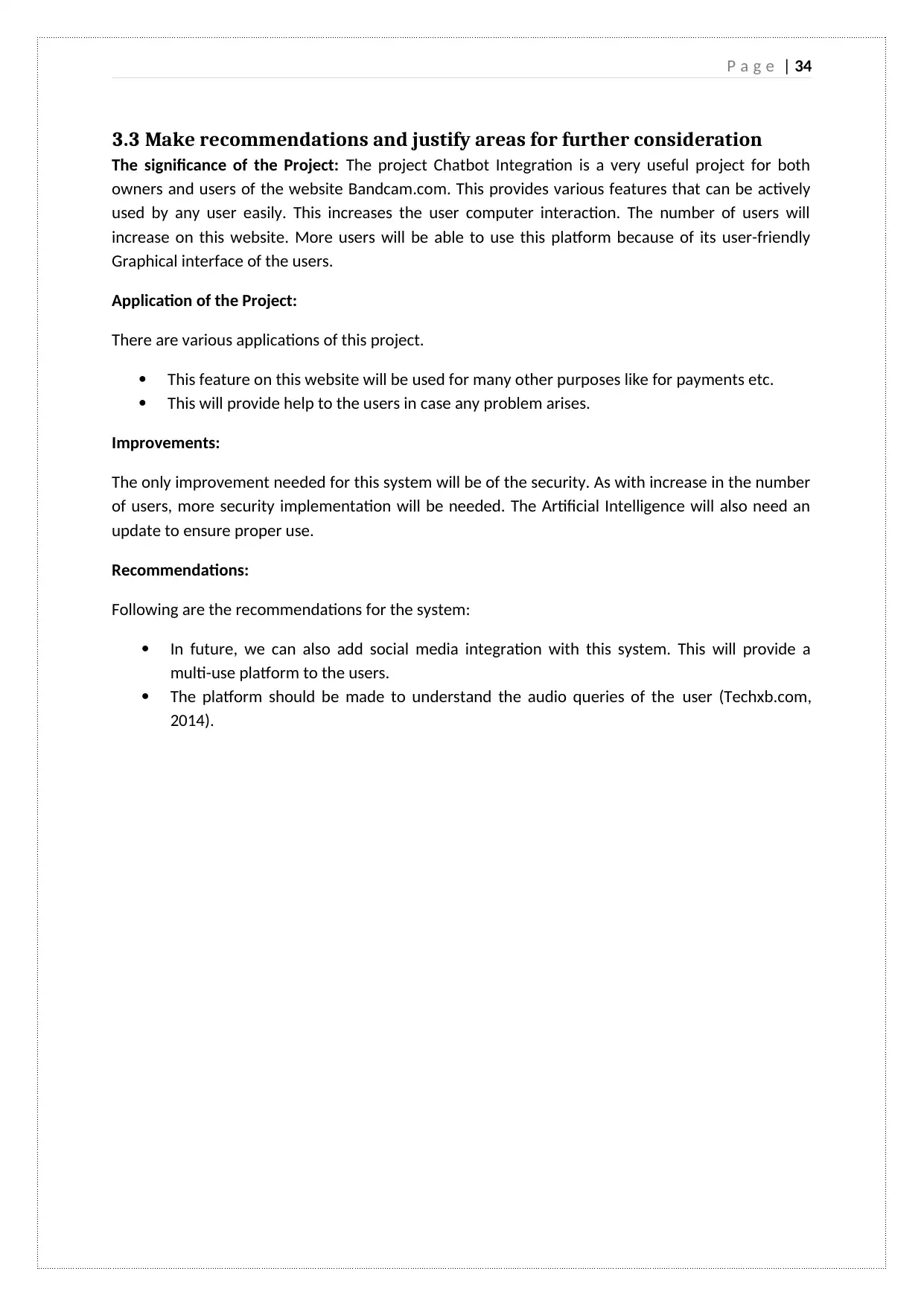
3.3 Make recommendations and justify areas for further consideration
The significance of the Project: The project Chatbot Integration is a very useful project for both
owners and users of the website Bandcam.com. This provides various features that can be actively
used by any user easily. This increases the user computer interaction. The number of users will
increase on this website. More users will be able to use this platform because of its user-friendly
Graphical interface of the users.
Application of the Project:
There are various applications of this project.
This feature on this website will be used for many other purposes like for payments etc.
This will provide help to the users in case any problem arises.
Improvements:
The only improvement needed for this system will be of the security. As with increase in the number
of users, more security implementation will be needed. The Artificial Intelligence will also need an
update to ensure proper use.
Recommendations:
Following are the recommendations for the system:
In future, we can also add social media integration with this system. This will provide a
multi-use platform to the users.
The platform should be made to understand the audio queries of the user (Techxb.com,
2014).
Paraphrase This Document
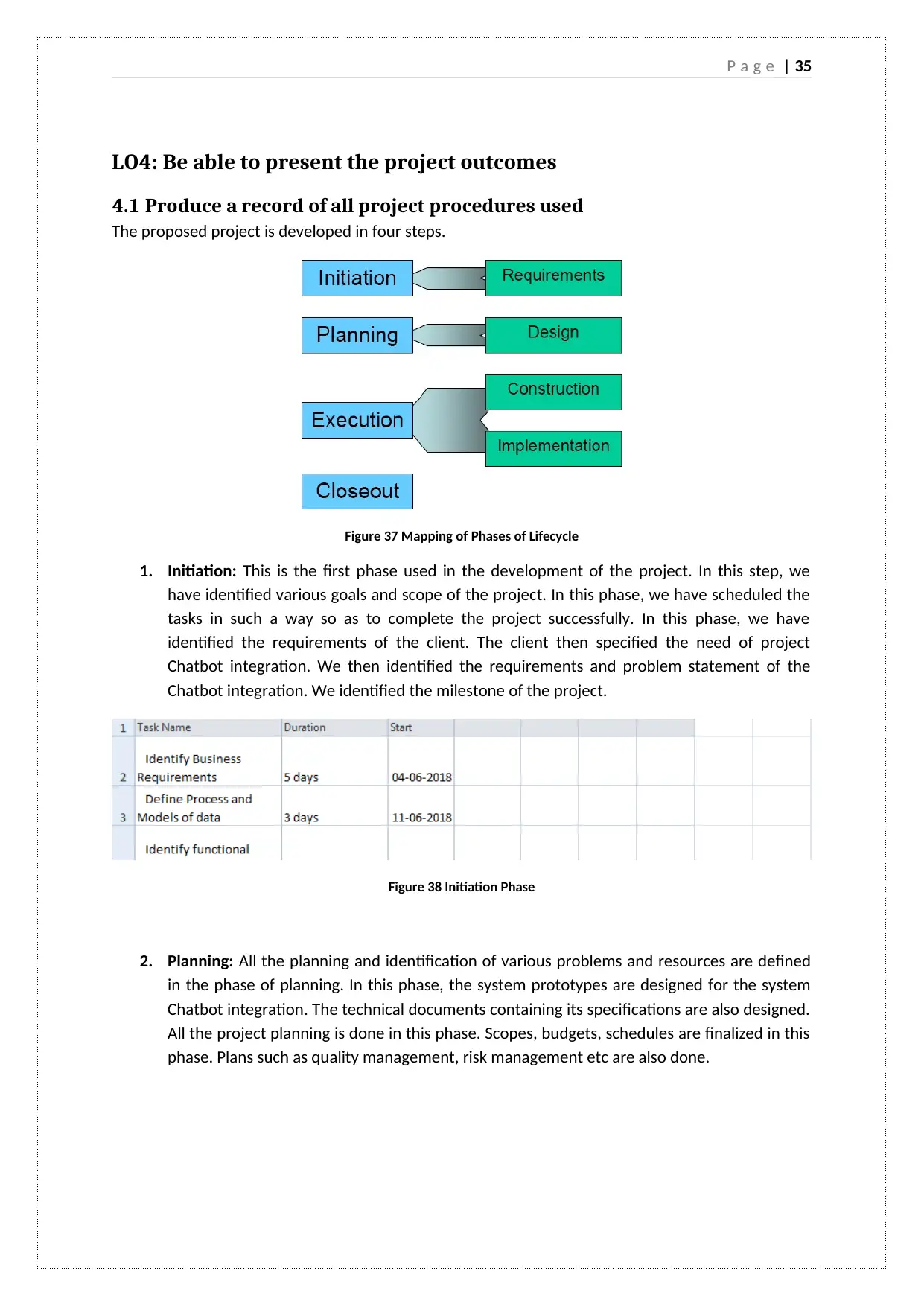
LO4: Be able to present the project outcomes
4.1 Produce a record of all project procedures used
The proposed project is developed in four steps.
Figure 37 Mapping of Phases of Lifecycle
1. Initiation: This is the first phase used in the development of the project. In this step, we
have identified various goals and scope of the project. In this phase, we have scheduled the
tasks in such a way so as to complete the project successfully. In this phase, we have
identified the requirements of the client. The client then specified the need of project
Chatbot integration. We then identified the requirements and problem statement of the
Chatbot integration. We identified the milestone of the project.
Figure 38 Initiation Phase
2. Planning: All the planning and identification of various problems and resources are defined
in the phase of planning. In this phase, the system prototypes are designed for the system
Chatbot integration. The technical documents containing its specifications are also designed.
All the project planning is done in this phase. Scopes, budgets, schedules are finalized in this
phase. Plans such as quality management, risk management etc are also done.
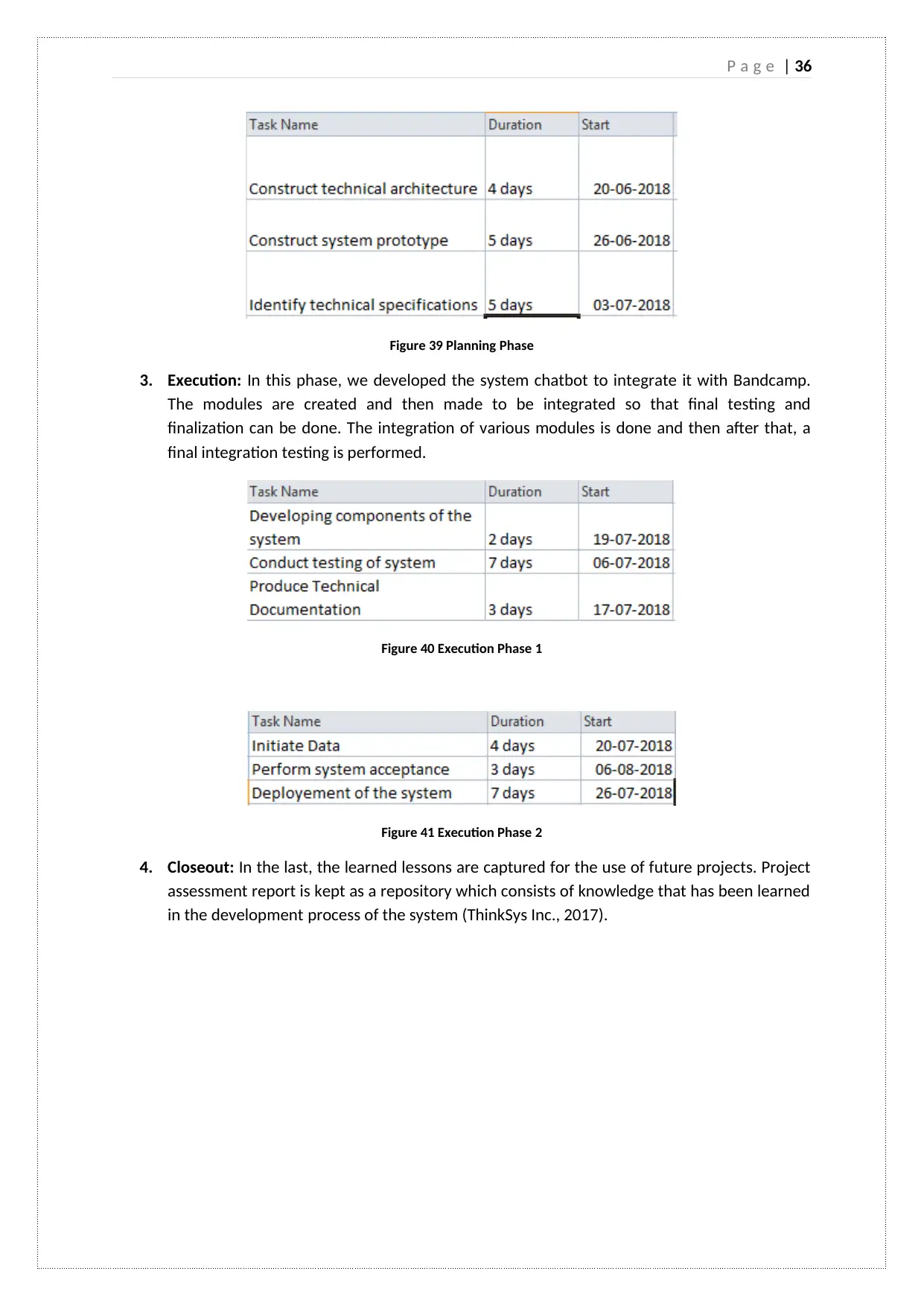
Figure 39 Planning Phase
3. Execution: In this phase, we developed the system chatbot to integrate it with Bandcamp.
The modules are created and then made to be integrated so that final testing and
finalization can be done. The integration of various modules is done and then after that, a
final integration testing is performed.
Figure 40 Execution Phase 1
Figure 41 Execution Phase 2
4. Closeout: In the last, the learned lessons are captured for the use of future projects. Project
assessment report is kept as a repository which consists of knowledge that has been learned
in the development process of the system (ThinkSys Inc., 2017).
⊘ This is a preview!⊘
Do you want full access?
Subscribe today to unlock all pages.

Trusted by 1+ million students worldwide
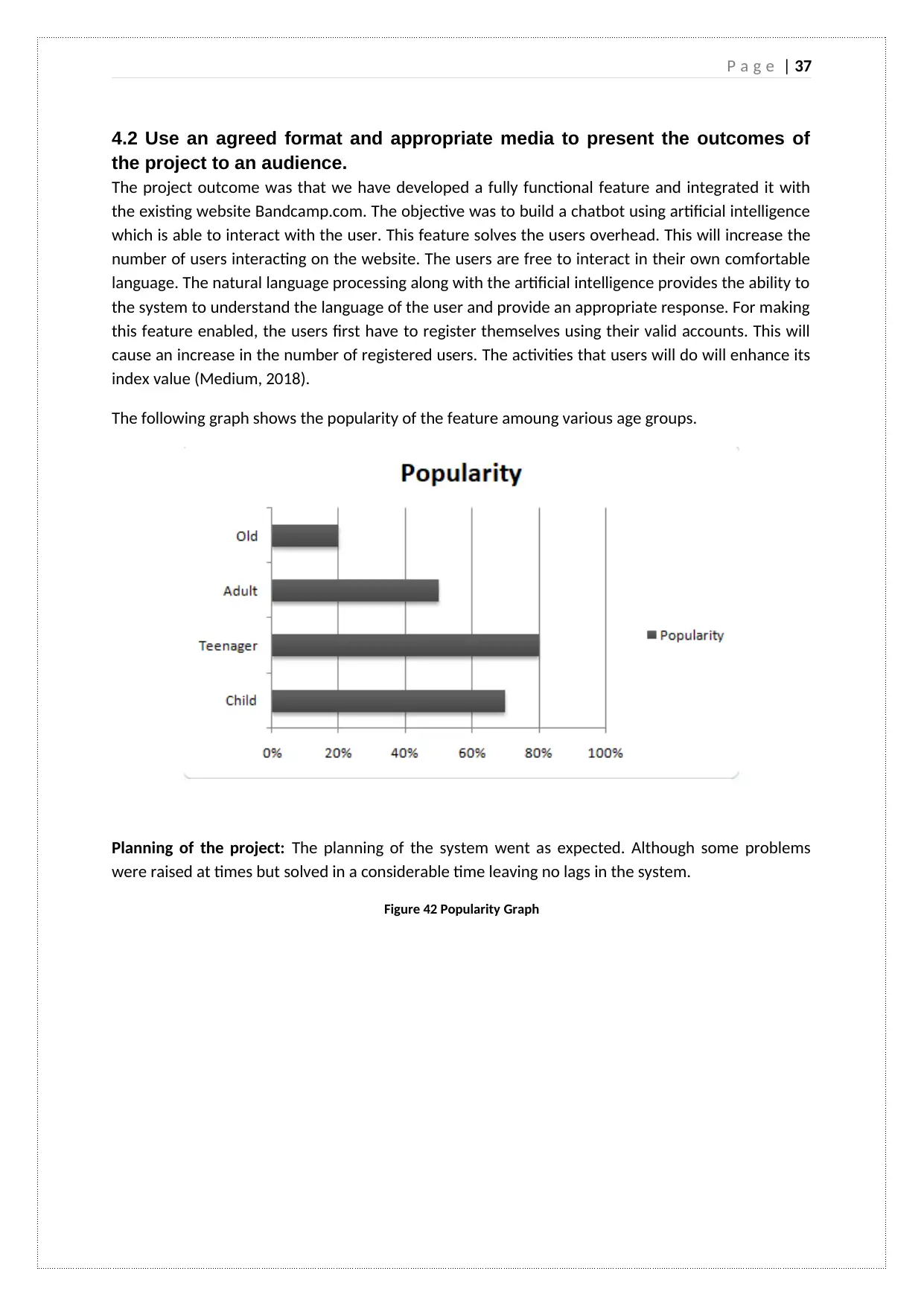
4.2 Use an agreed format and appropriate media to present the outcomes of
the project to an audience.
The project outcome was that we have developed a fully functional feature and integrated it with
the existing website Bandcamp.com. The objective was to build a chatbot using artificial intelligence
which is able to interact with the user. This feature solves the users overhead. This will increase the
number of users interacting on the website. The users are free to interact in their own comfortable
language. The natural language processing along with the artificial intelligence provides the ability to
the system to understand the language of the user and provide an appropriate response. For making
this feature enabled, the users first have to register themselves using their valid accounts. This will
cause an increase in the number of registered users. The activities that users will do will enhance its
index value (Medium, 2018).
The following graph shows the popularity of the feature amoung various age groups.
Planning of the project: The planning of the system went as expected. Although some problems
were raised at times but solved in a considerable time leaving no lags in the system.
Figure 42 Popularity Graph
Paraphrase This Document
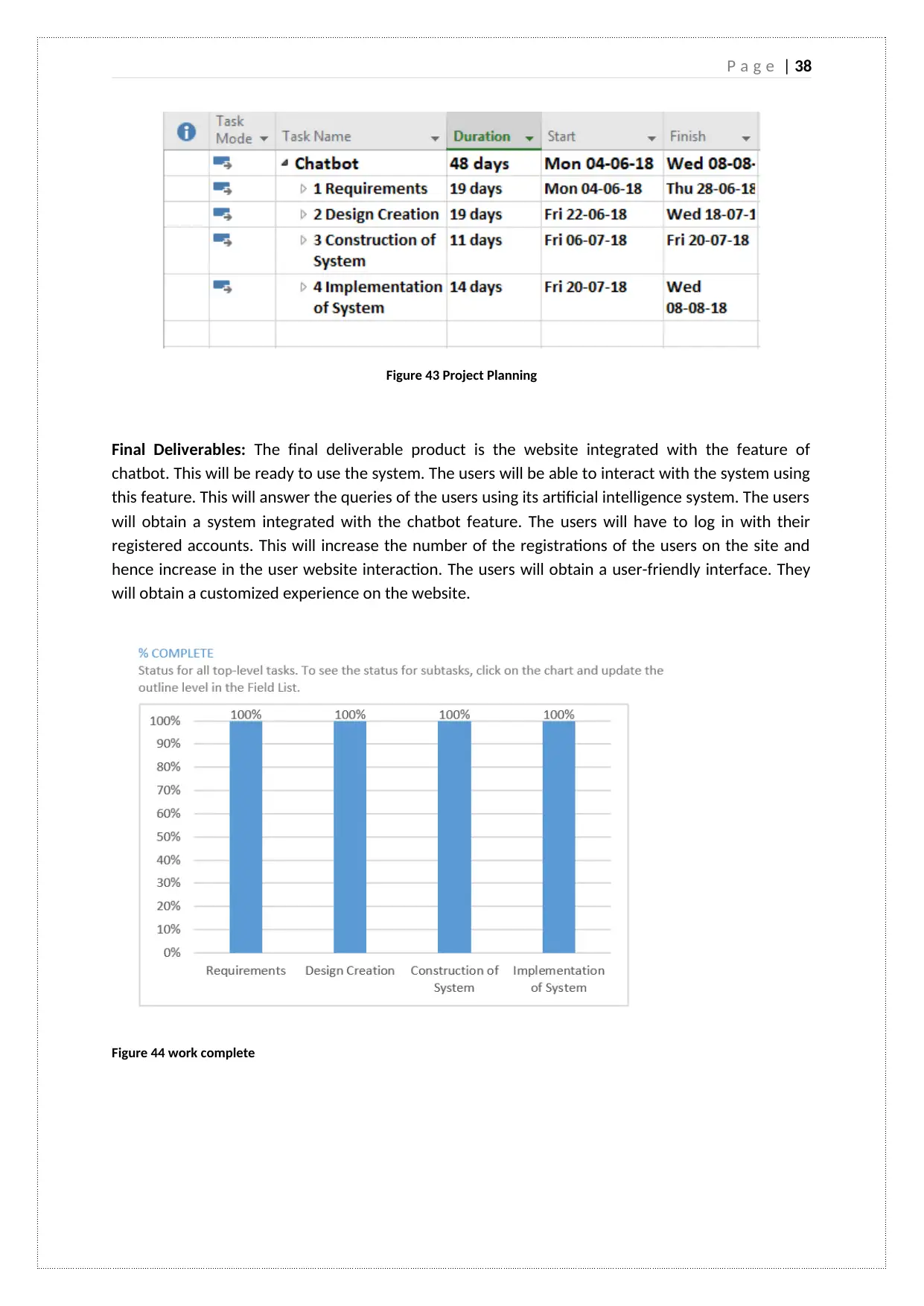
Figure 43 Project Planning
Final Deliverables: The final deliverable product is the website integrated with the feature of
chatbot. This will be ready to use the system. The users will be able to interact with the system using
this feature. This will answer the queries of the users using its artificial intelligence system. The users
will obtain a system integrated with the chatbot feature. The users will have to log in with their
registered accounts. This will increase the number of the registrations of the users on the site and
hence increase in the user website interaction. The users will obtain a user-friendly interface. They
will obtain a customized experience on the website.
Figure 44 work complete
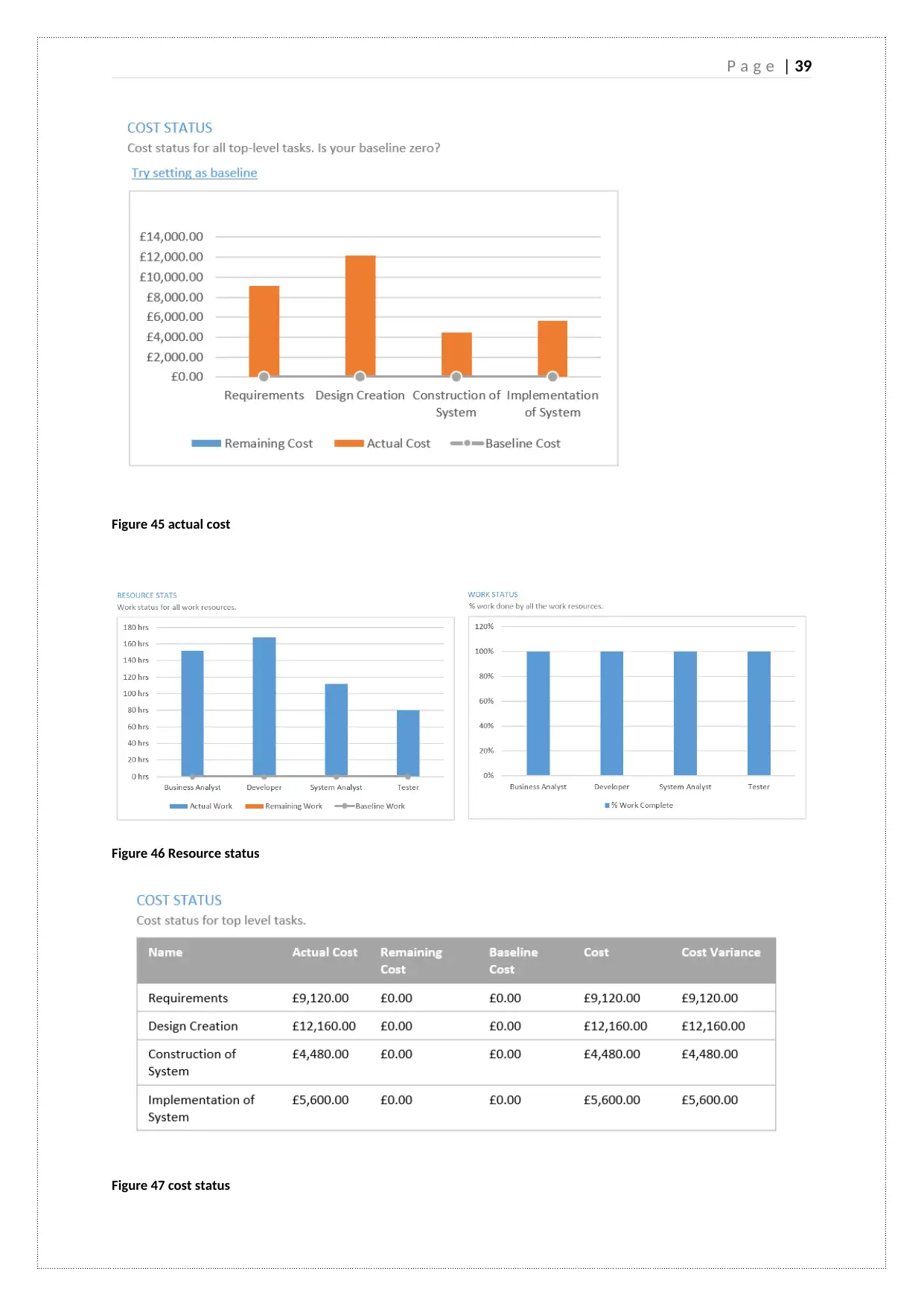
Figure 45 actual cost
Figure 46 Resource status
Figure 47 cost status
⊘ This is a preview!⊘
Do you want full access?
Subscribe today to unlock all pages.

Trusted by 1+ million students worldwide
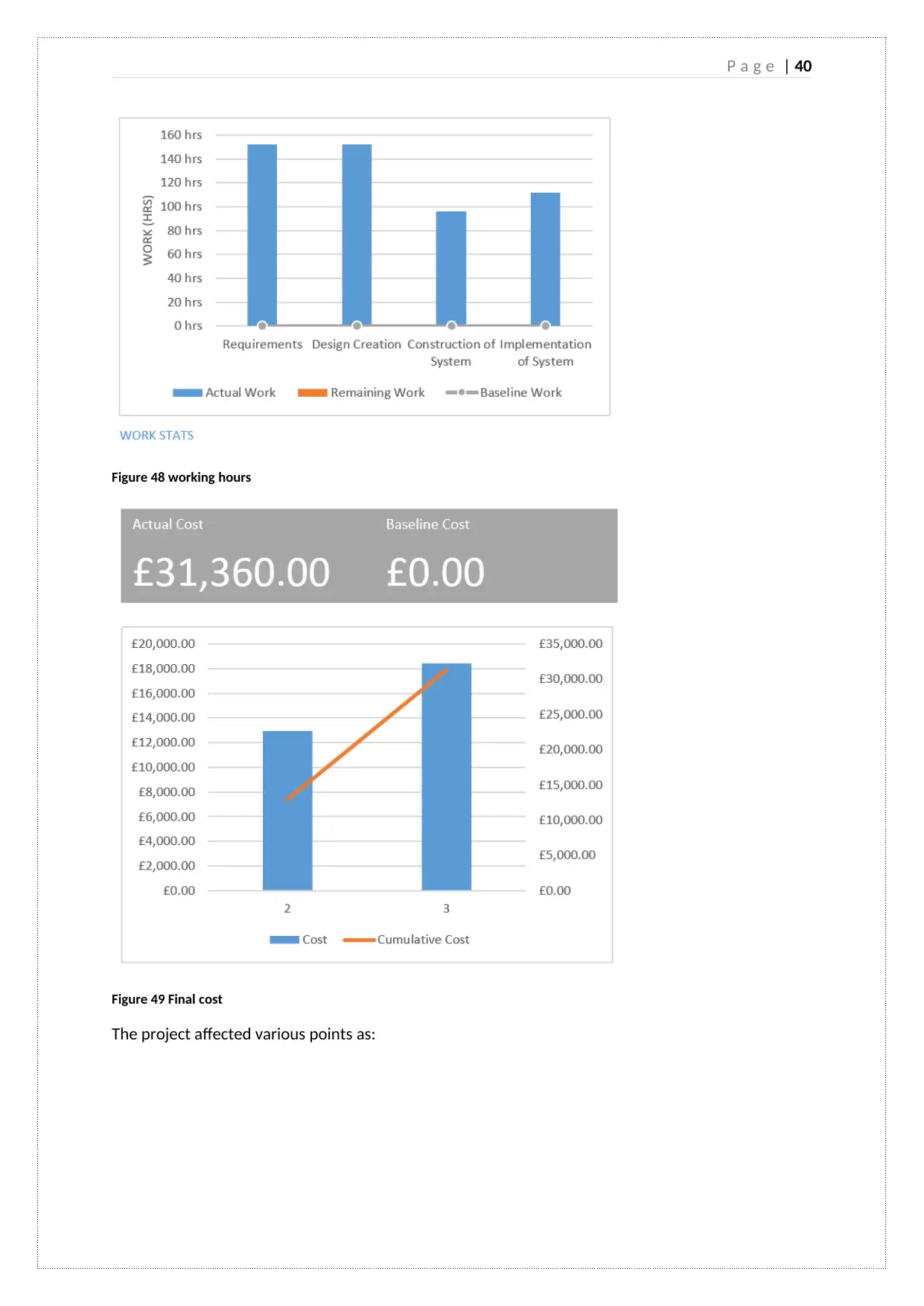
Figure 48 working hours
Figure 49 Final cost
The project affected various points as:
Paraphrase This Document

Figure 50 new users
Figure 51 Satisfaction level after integrating

Figure 52 Services
⊘ This is a preview!⊘
Do you want full access?
Subscribe today to unlock all pages.

Trusted by 1+ million students worldwide
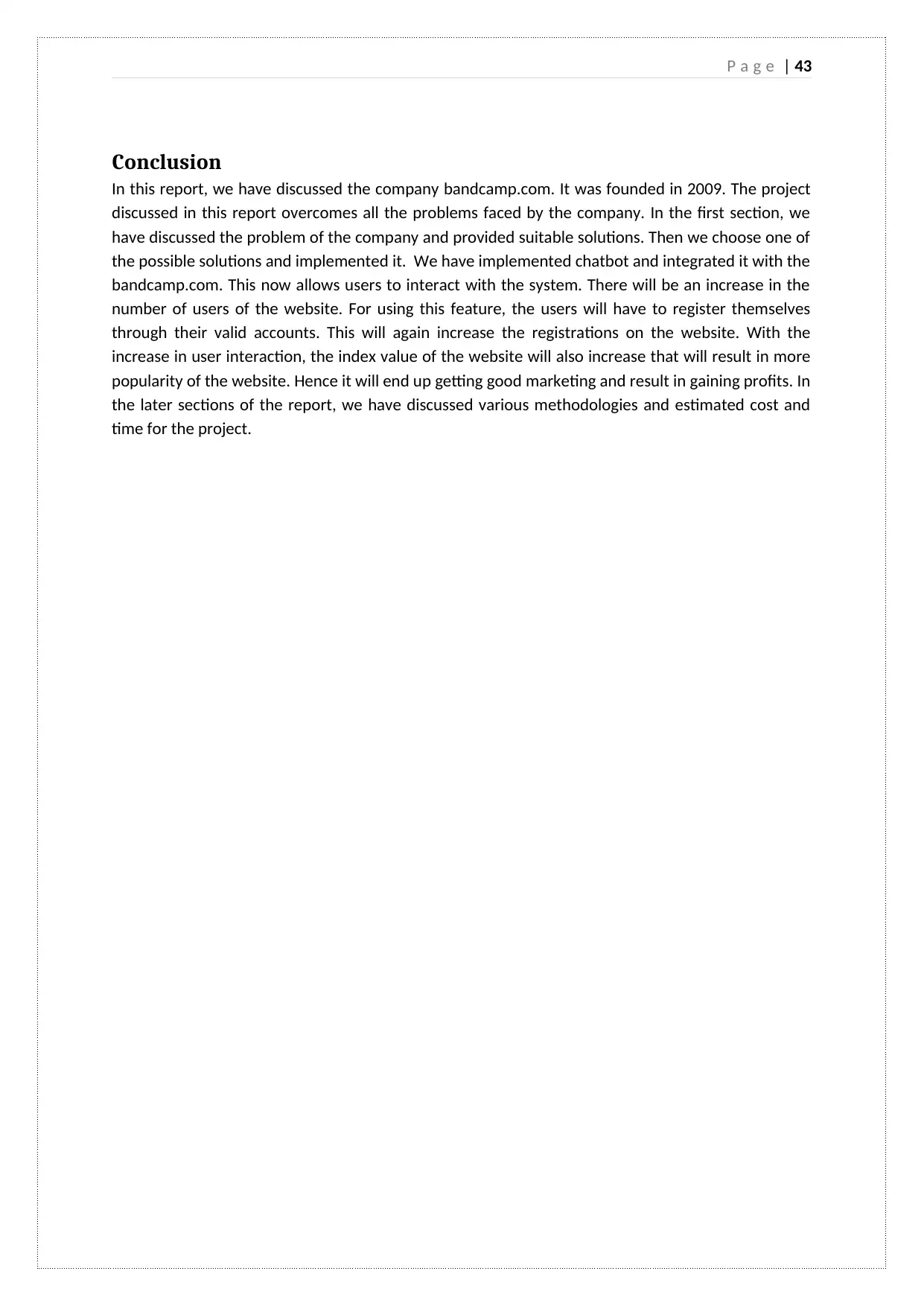
Conclusion
In this report, we have discussed the company bandcamp.com. It was founded in 2009. The project
discussed in this report overcomes all the problems faced by the company. In the first section, we
have discussed the problem of the company and provided suitable solutions. Then we choose one of
the possible solutions and implemented it. We have implemented chatbot and integrated it with the
bandcamp.com. This now allows users to interact with the system. There will be an increase in the
number of users of the website. For using this feature, the users will have to register themselves
through their valid accounts. This will again increase the registrations on the website. With the
increase in user interaction, the index value of the website will also increase that will result in more
popularity of the website. Hence it will end up getting good marketing and result in gaining profits. In
the later sections of the report, we have discussed various methodologies and estimated cost and
time for the project.
Paraphrase This Document
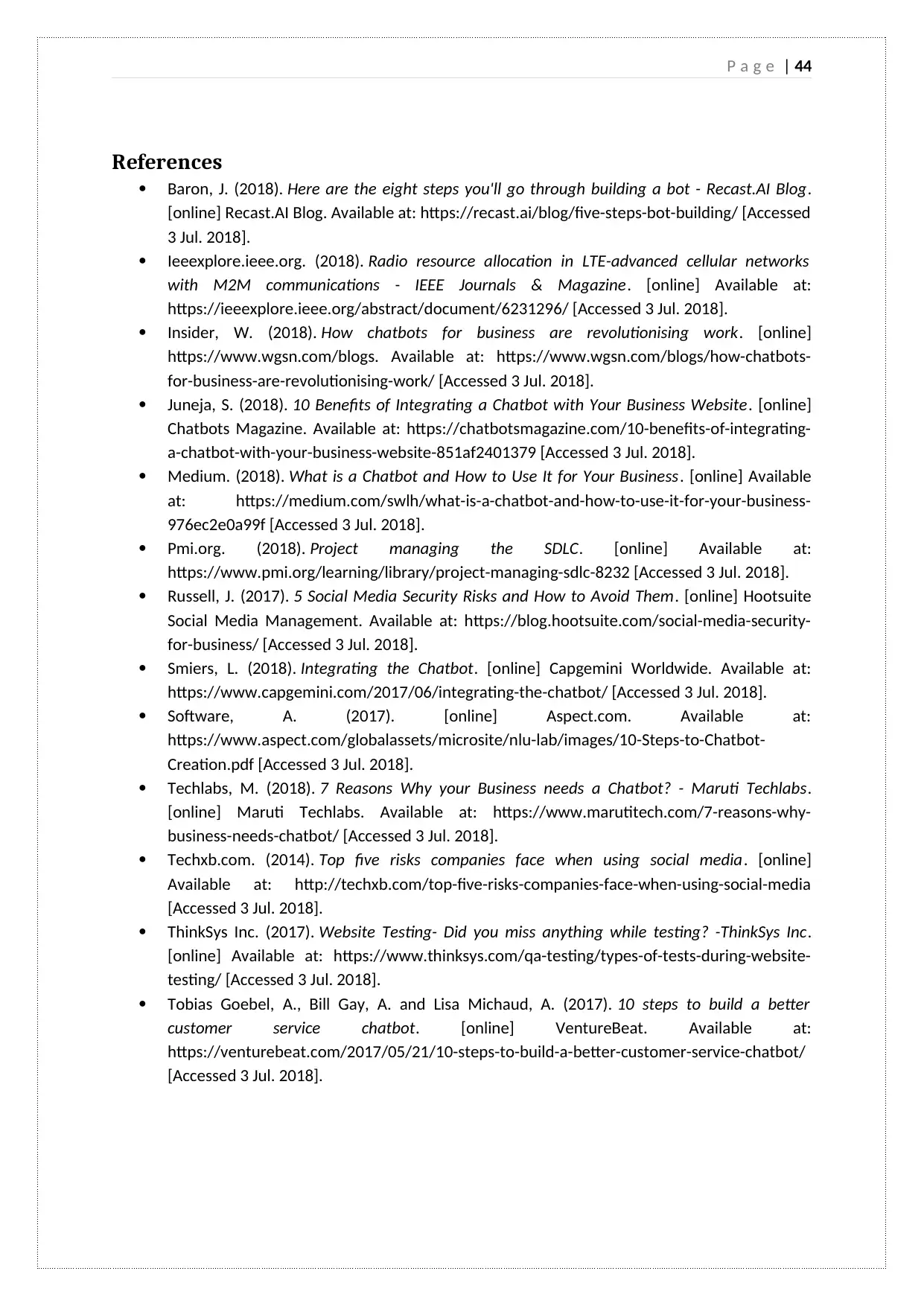
References
Baron, J. (2018). Here are the eight steps you'll go through building a bot - Recast.AI Blog.
[online] Recast.AI Blog. Available at: https://recast.ai/blog/five-steps-bot-building/ [Accessed
3 Jul. 2018].
Ieeexplore.ieee.org. (2018). Radio resource allocation in LTE-advanced cellular networks
with M2M communications - IEEE Journals & Magazine. [online] Available at:
https://ieeexplore.ieee.org/abstract/document/6231296/ [Accessed 3 Jul. 2018].
Insider, W. (2018). How chatbots for business are revolutionising work. [online]
https://www.wgsn.com/blogs. Available at: https://www.wgsn.com/blogs/how-chatbots-
for-business-are-revolutionising-work/ [Accessed 3 Jul. 2018].
Juneja, S. (2018). 10 Benefits of Integrating a Chatbot with Your Business Website. [online]
Chatbots Magazine. Available at: https://chatbotsmagazine.com/10-benefits-of-integrating-
a-chatbot-with-your-business-website-851af2401379 [Accessed 3 Jul. 2018].
Medium. (2018). What is a Chatbot and How to Use It for Your Business. [online] Available
at: https://medium.com/swlh/what-is-a-chatbot-and-how-to-use-it-for-your-business-
976ec2e0a99f [Accessed 3 Jul. 2018].
Pmi.org. (2018). Project managing the SDLC. [online] Available at:
https://www.pmi.org/learning/library/project-managing-sdlc-8232 [Accessed 3 Jul. 2018].
Russell, J. (2017). 5 Social Media Security Risks and How to Avoid Them. [online] Hootsuite
Social Media Management. Available at: https://blog.hootsuite.com/social-media-security-
for-business/ [Accessed 3 Jul. 2018].
Smiers, L. (2018). Integrating the Chatbot. [online] Capgemini Worldwide. Available at:
https://www.capgemini.com/2017/06/integrating-the-chatbot/ [Accessed 3 Jul. 2018].
Software, A. (2017). [online] Aspect.com. Available at:
https://www.aspect.com/globalassets/microsite/nlu-lab/images/10-Steps-to-Chatbot-
Creation.pdf [Accessed 3 Jul. 2018].
Techlabs, M. (2018). 7 Reasons Why your Business needs a Chatbot? - Maruti Techlabs.
[online] Maruti Techlabs. Available at: https://www.marutitech.com/7-reasons-why-
business-needs-chatbot/ [Accessed 3 Jul. 2018].
Techxb.com. (2014). Top five risks companies face when using social media. [online]
Available at: http://techxb.com/top-five-risks-companies-face-when-using-social-media
[Accessed 3 Jul. 2018].
ThinkSys Inc. (2017). Website Testing- Did you miss anything while testing? -ThinkSys Inc.
[online] Available at: https://www.thinksys.com/qa-testing/types-of-tests-during-website-
testing/ [Accessed 3 Jul. 2018].
Tobias Goebel, A., Bill Gay, A. and Lisa Michaud, A. (2017). 10 steps to build a better
customer service chatbot. [online] VentureBeat. Available at:
https://venturebeat.com/2017/05/21/10-steps-to-build-a-better-customer-service-chatbot/
[Accessed 3 Jul. 2018].
Related Documents
Your All-in-One AI-Powered Toolkit for Academic Success.
+13062052269
info@desklib.com
Available 24*7 on WhatsApp / Email
![[object Object]](/_next/static/media/star-bottom.7253800d.svg)
© 2024 | Zucol Services PVT LTD | All rights reserved.





